Abstract
As the demand for energy-efficient homes continues to rise, the importance of advanced mechanical ventilation systems in maintaining indoor air quality (IAQ) has become increasingly evident. However, challenges related to energy balance, IAQ, and occupant thermal comfort persist. This review examines the performance of mechanical ventilation systems in regulating indoor climate, improving air quality, and minimising energy consumption. The findings indicate that demand-controlled ventilation (DCV) can enhance energy efficiency by up to 88% while maintaining CO2 concentrations below 1000 ppm during 76% of the occupancy period. Heat recovery systems achieve efficiencies of nearly 90%, leading to a reduction in heating energy consumption by approximately 19%. Studies also show that employing mechanical rather than natural ventilation in schools lowers CO2 levels by 20–30%. Nevertheless, occupant misuse or poorly designed systems can result in CO2 concentrations exceeding 1600 ppm in residential environments. Hybrid ventilation systems have demonstrated improved thermal comfort, with predicted mean vote (PMV) values ranging from –0.41 to 0.37 when radiant heating is utilized. Despite ongoing technological advancements, issues such as system durability, user acceptance, and adaptability across climate zones remain. Smart, personalized ventilation strategies supported by modern control algorithms and continuous monitoring are essential for the development of resilient and health-promoting buildings. Future research should prioritize the integration of renewable energy sources and adaptive ventilation controls to further optimise system performance.
1. Introduction
A healthy and safe indoor environment significantly influences occupants’ health, mood, and productivity, with indoor air quality (IAQ) being a primary contributing factor. Given that individuals now spend approximately 90% of their time indoors, adequate ventilation has become increasingly critical [1]. The World Health Organization (WHO) emphasizes the importance of controlling humidity, preventing mould growth, and maintaining high indoor air quality as essential priorities for indoor environments [2]. In response, the recognition of mechanical ventilation systems as integral components of sustainable building design has spurred a growing body of research. Recent advancements in mechanical ventilation systems have been driven by heightened awareness of airborne disease transmission, the importance of reducing energy usage, and the need for precise climate control across diverse building typologies. The COVID-19 pandemic and related events have underscored the crucial role of effective ventilation in mitigating the spread of infectious respiratory droplets and aerosols [3]. Empirical evidence supports the assertion that adequate air circulation, particularly in educational settings, significantly reduces the risk of airborne disease transmission, promoting the use of mechanical ventilation [4]. Modern ventilation involves more than simply increasing air exchange rates. Contemporary mechanical ventilation systems are expected to meet multiple objectives simultaneously: ensuring good indoor air quality, maintaining thermal comfort, minimising electricity usage, and protecting interiors from outdoor air pollutants. Achieving these goals requires a comprehensive understanding of aerosol dynamics within indoor spaces, as demonstrated by recent research conducted in operating theatres and educational facilities [5]. Ventilation performance is influenced not only by airflow patterns but also by occupancy density and activity levels. Balancing the need for fresh air with the needs of energy conservation presents a significant challenge in building design. Globally, heating and cooling demands represent a substantial portion of total energy usage, with HVAC systems accounting for a large part of this usage [6]. Efforts to enhance energy efficiency have led to increasingly airtight building envelopes, necessitating reliable ventilation strategies to manage indoor pollutant accumulation. Germany’s energy transition strategy exemplifies this balance, emphasizing both energy savings and maintaining a good indoor air quality level [7]. However, improvements in energy efficiency can lead to behavioural adaptations that potentially offset some of the intended benefits [8]. Understanding these behavioural responses is essential in designing mechanical ventilation systems that successfully reconcile energy efficiency with indoor air quality objectives. One of the most recent advancement in ventilation technology is demand-controlled ventilation (DCV), which reduces energy usage without compromising indoor air quality. Research has demonstrated that occupancy-based ventilation control can significantly decrease energy use in Norwegian primary schools while maintaining acceptable indoor environmental conditions [9]. These findings suggest that intelligent control strategies can effectively tailor ventilation rates to real-time occupancy and pollutant levels. Contemporary leaders in mechanical ventilation increasingly incorporate natural environmental elements to reduce system workload and energy consumption. Influential design pioneers such as Victor Olgyay laid the foundational principles for climate-responsive architecture, which remain highly relevant in current ventilation practices [10]. His work emphasizes the importance of understanding local climatic conditions and maximizing natural ventilation whenever feasible. This integration of natural and mechanical ventilation systems offers an effective hybrid approach. The International Energy Agency (IEA) provides detailed guidelines for implementing hybrid strategies, particularly for ventilated cooling [11]. Emerging technologies in this area offer the potential to reduce cooling energy demand while maintaining thermal comfort [12]. However, the performance of ventilated cooling is often constrained by outdoor air quality, as elevated levels of pollution can limit the feasibility of utilising outdoor air for indoor cooling purposes [13]. Developing effective mechanical ventilation strategies requires a deep understanding of air quality standards and appropriate assessment methodologies. Over several decades, organizations such as ASHRAE have played a pivotal role in refining international standards across diverse building contexts [14]. While these standards define minimum ventilation requirements based on occupancy and contaminant levels, real-world application necessitates consideration of local climatic conditions, building typologies, and usage patterns. In educational settings, where occupancy density is typically high, monitoring carbon dioxide (CO2) concentrations serves as a practical indicator of ventilation effectiveness [15]. Research has identified associations between elevated indoor CO2 levels and declines in both cognitive performance and physical well-being [16]. The WHO provides comprehensive guidelines on the health impacts of various indoor air pollutants, emphasizing the need for effective ventilation strategies [17]. Several studies have documented correlations between classroom air quality and student outcomes. Poor ventilation has been associated with increased absenteeism and decreased academic performance, underscoring the broader significance of mechanical ventilation systems in educational environments [18]. These findings reinforce the argument that enhanced indoor air quality offers systemic benefits that extend beyond individual health. Understanding how occupants interact with ventilation systems is crucial for ensuring their effective operation. Studies have shown that user behaviour significantly influences both energy usage and indoor air quality outcomes [19]. Gaining insight into these behavioural patterns is essential for aligning system performance with real-world use, as opposed to idealized operating conditions. Occupant interactions with both natural and mechanical ventilation systems are shaped by several factors, including awareness of system controls, perceived benefits, and environmental triggers that prompt user engagement [20]. The complexity of these interactions has spurred interest in developing automated or semi-automated control systems that require minimal user intervention. Cross-cultural studies indicate that preferences for ventilation practices vary based on climatic conditions and cultural norms [21]. These findings highlight the importance of designing ventilation strategies that address not only technical specifications but also local traditions, behavioural habits, and user expectations. Despite advancements in knowledge and technology, numerous challenges persist in implementing effective mechanical ventilation strategies. Mixed-method research has become a widely used approach for examining the interrelationships between building performance, occupant experience, and energy consumption [22]. Empirical findings frequently indicate a discrepancy between the predicted and actual performance of buildings in operation. This performance gap underscores the importance of continuous commissioning, systematic fault detection, and sustained efforts to optimise system functionality. Integrating mechanical ventilation systems with other building components becomes particularly complex in retrofit projects, where spatial and infrastructural constraints often limit design flexibility. Although ventilation upgrades in existing buildings can yield substantial benefits, they also introduce a range of technical and operational difficulties [23]. These projects typically demonstrate that achieving both good indoor air quality and energy efficiency requires careful attention to the building envelope, the interoperability of mechanical systems, and the building’s operational dynamics. Emerging technologies in monitoring and control are enhancing the performance and responsiveness of mechanical ventilation systems. Recent advancements in CO2 sensors and automated data analytics have significantly improved the ability to estimate air change rates and evaluate system effectiveness with greater precision [24]. These technologies support the development of intelligent control systems capable of adapting to variable conditions, thereby optimising ventilation performance across multiple objectives, including air quality, energy use, and occupant comfort [25].
The aim of this review is to systematically synthesize current developments in mechanical ventilation (MEV), with a particular focus on the integration of IAQ, energy efficiency, climate-responsive control, and thermal comfort in both conventional and specialized building types. While numerous studies have addressed individual aspects of ventilation, such as IAQ standards, energy performance, and occupant behaviour, a critical gap remains in the literature regarding how these dimensions interact under real-world conditions, particularly in the presence of dynamic occupancy patterns, diverse climatic contexts, and varying levels of system automation. This review addresses that gap by critically examining empirical performance data, user behaviour, and the implementation of intelligent ventilation strategies to assess the operational effectiveness of MEV systems. The analysis explores whether MEV can significantly reduce energy usage without compromising air quality, for example, by achieving substantial energy savings while maintaining indoor CO2 concentrations within acceptable thresholds. It also examines the contribution of hybrid ventilation and heat recovery systems to enhancing occupant comfort, as assessed through thermal comfort indices such as the predicted mean vote (PMV), predicted percentage of dissatisfied (PPD), and draught rate (DR). Furthermore, the review identifies key implementation challenges, including system durability, occupant satisfaction, and climate adaptability, that remain persistent barriers to the broader adoption of advanced ventilation solutions. By integrating previously fragmented theoretical and empirical insights into a cohesive analytical framework, this review fills a critical knowledge gap in the interdisciplinary understanding of mechanical ventilation performance. It provides researchers, engineers, and policymakers with a comprehensive foundation for advancing the design, deployment, and context-sensitive adaptation of next-generation ventilation systems.
2. Review Method
The authors reviewed peer-reviewed journal articles, conference proceedings, and technical reports published between 2010 and 2025 to examine recent advancements in mechanical ventilation for buildings. The literature search focused on keywords such as “mechanical ventilation,” “indoor air quality,” “IAQ,” “energy efficiency,” and “thermal comfort,” and was conducted using major academic databases, including ScienceDirect, Scopus, and Web of Science. The selected studies were categorized into five primary thematic areas: (1) ventilation rate measurement and control, (2) indoor air quality (IAQ) and health, (3) energy efficiency and heat recovery, (4) thermal comfort and hybrid systems, and (5) computational fluid dynamics (CFD) and numerical modelling, as detailed in the paper. Inclusion criteria emphasized empirical studies, validated field measurements, and simulation results with demonstrated accuracy. Non-English publications and non-peer-reviewed literature were excluded from the review. Quantitative data were primarily extracted for indicators such as indoor CO2 concentrations, energy usage, and thermal comfort thresholds, typically expressed through PMV and PPD metrics. The critical synthesis of these studies revealed patterns, contradictory results, and significant research gaps. These findings are summarized in a series of comparative tables. The review also identifies a regional bias in the existing literature, with a predominant focus on temperate climate zones. This limitation should be taken into account when designing future studies, especially those aiming to inform global best practices. The distribution of reviewed studies over time is illustrated in Figure 1, which presents the number of included publications by year. This process ensures a comprehensive overview of the current research landscape in mechanical ventilation.
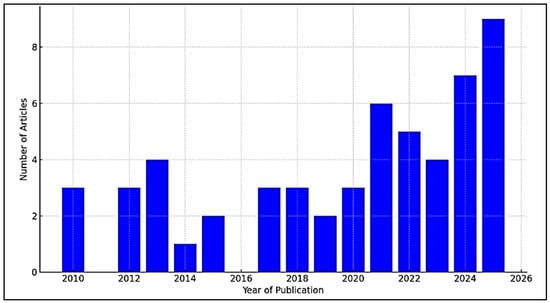
Figure 1.
The number of articles by year of publication.
2.1. Studies Related to Ventilation Rate Measurement and Control
A system for monitoring ventilation in a mechanically ventilated commercial broiler farm was proposed by Calvet et al. (2010) [26] in which constant-flow fans were utilized. The system incorporated a low-voltage direct current (DC) circuit connected to the signal circuits of the fan motor relays. Observations were conducted over a 46-day cooling period and a 36-day heating period, during which the accuracy of the system’s measurements was evaluated. The system provided reliable data on individual fan operation times and hourly ventilation rates, assuming that the ventilation rate of each fan was known. To assess airflow measurement uncertainty, Monte Carlo simulations were employed. In most cases, uncertainties did not exceed 10% of the measured values. However, the accuracy decreased as the number of monitored fans was reduced. This effect was especially pronounced at high ventilation rates; when operating at 100% capacity, measurement error increased from 5.3% to 19.1%, depending on the number of fans included in the assessment. In a separate study, Lu et al. (2010) [27] developed a method for estimating both air change rates and CO2 generation within a given indoor space using existing CO2 concentration data. Initially, the air change rate was determined using the maximum likelihood estimation (MLE) method, followed by a novel approach to estimate CO2 generation rates with improved accuracy. The methodology was validated using both simulation and laboratory data. A series of experiments was conducted in a school office in which indoor CO2 concentrations and pressure variations at the return air vent were continuously monitored. The model achieved excellent agreement with the measured data. Specifically, the MLE-based estimation of the air change rate yielded a coefficient of determination (R2) of at least 0.998, with residual plots showing no discernible patterns or trends, indicating a strong fit. As shown in Figure 2, five days of data were collected at five-minute intervals. The results consistently showed minimal pressure fluctuations during working hours.
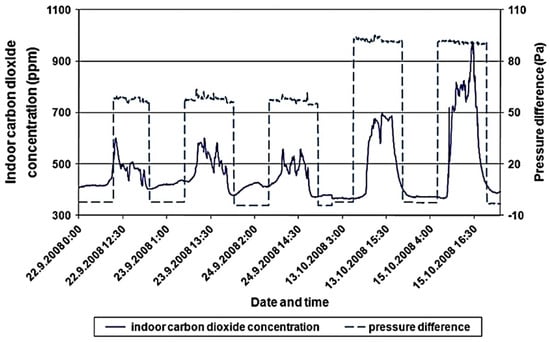
Figure 2.
CO2 content and pressure differential between the room and return air vent were measured inside [27].
In 2013, Turner et al. [28] demonstrated that implementing residential whole-house ventilation systems in accordance with California’s Title 24 standards [29] can yield multiple benefits. Simulation studies were conducted to evaluate both occupant health outcomes and energy consumption in scenarios where whole-house ventilation systems were either properly or improperly functioning. The impacts on energy use and IAQ were assessed separately and compared using time-dependent valuation (TDV) for energy and disability-adjusted life years (DALY) for IAQ. Regardless of house size or climatic conditions, the study emphasized that health benefits were the most significant outcome. The authors argued that the net present value (NPV) of both energy savings and improved IAQ should serve as the primary criterion when selecting whole-house ventilation systems. As illustrated in Figure 3, binomial response curves show how outcomes vary with increasing ventilation rates, particularly beyond 300% of the ASHRAE 62.2 standard [30]. At higher ventilation levels, the NPV begins to decline due to the diminishing marginal benefit from further reductions in indoor contaminant concentrations.
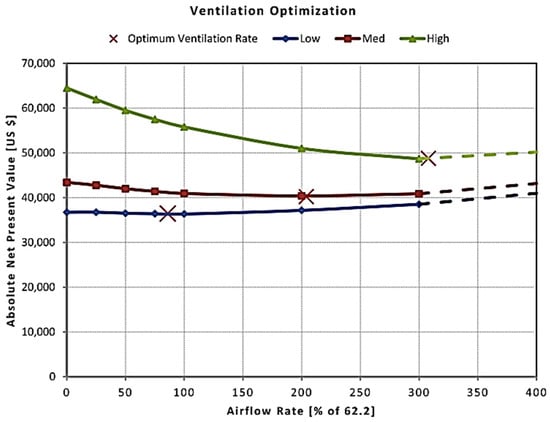
Figure 3.
Curves of optimisation for energy and IAQ. The points that indicate the lowest expense to the residents are known as the local minima [28].
Shi and Li (2018) [31] developed theoretical models describing how increases in mechanical ventilation influence infiltration rates. They derived equations that relate infiltration rates to mechanical ventilation under both stack effect and wind-driven ventilation conditions. The theoretical framework was validated through experimental testing conducted in controlled room environments. Figure 4 illustrates the relationship between mechanical ventilation and various levels of building airtightness. Air exchange rates (ACH) are expressed in air changes per hour (h−1), defined as the airflow rate divided by the volume of the room. As shown in Figure 4, when initial infiltration exceeds 0.5 h−1, mechanical ventilation accounts for less than 55% of the total required airflow.
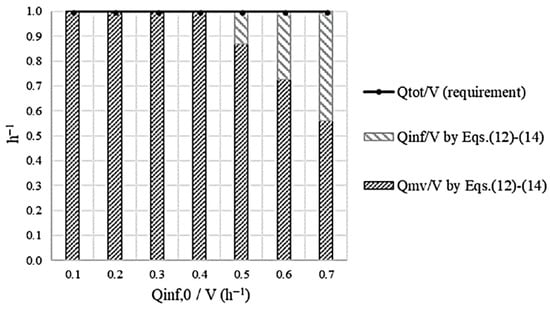
Figure 4.
Results of a case study on excessive ventilation [31].
Shi and Li (2020) [32] investigated the influence of mechanical ventilation rates on infiltration in buildings equipped with multilayer windows. They developed a mathematical model to describe the relationship between mechanical ventilation and infiltration rates. The model was validated through field experiments conducted in a large indoor space. The validated approach enables determination of the minimum mechanical ventilation rate required to prevent outdoor air infiltration in buildings with multilayer windows. The relationship between mechanical ventilation and infiltration depends on several architectural parameters, including the window’s aspect ratio (width-to-height), vertical spacing between window units, and the number of window layers.
Zhang et al. (2021) [33] proposed a novel DCV strategy for mechanical systems operating under constant air volume conditions. To maximize efficiency, the system runs continuously and adjusts between full-load, quasi-full-load, and partial-load modes based on real-time indoor CO2 concentration. Although setting wider upper and lower CO2 thresholds improves energy efficiency, it may also compromise indoor air quality and accelerate system wear due to frequent switching. To address this trade-off, a genetic algorithm was used to minimize energy consumption while maintaining acceptable indoor air quality and reducing unnecessary switching operations. The proposed strategy achieves up to 88% energy savings without compromising indoor air quality or system performance.
In a specific study, Shin et al. (2023) [34] developed a weather-predictive temperature control system for animal shelters. A building energy model tailored to livestock housing was constructed using real measurement data. Simulation experiments involved manipulating four air-conditioning control parameters to develop an optimal ventilation strategy. The newly developed strategy outperformed conventional methods in maintaining thermal comfort, achieving a 20.5% improvement in energy performance. Additionally, the quality scores of the ESP (energy simulation performance) improved as the accuracy of weather forecasts increased.
Chiesa and Vigliotti (2024) [35] evaluated multiple remote control configurations for three demand-controlled mechanical ventilation (DMV) systems installed in a demonstration junior high school building in Torre Pellice (Northwest Italy), continuously monitored since April 2021. Their analysis incorporated in situ measurements, room-level DMV monitoring via sensors, and simulations performed using the Energy Management System module of EnergyPlus. Eight IAQ control logics were assessed during the neutral season using metrics for indoor air quality, temperature, and energy demand. A full-year assessment of energy use was conducted by analysing fan power consumption and overall energy savings. Among the strategies, threshold-based control outperformed time-based control in terms of air quality. While all control methods maintained excellent IAQ, their energy-saving potential was comparatively modest. Notably, in contrast to simulation predictions, the actual indoor CO2 concentrations hovered around 600 ppm rather than stabilizing at the target level of 800 ppm. As shown in Figure 5, this discrepancy is less evident during neutral seasons but becomes more pronounced in winter months. Figure 5 specifically contrasts CO2 concentrations (ppm) in the DMV room using “Strategy I” and a reference room. The DMV room steadily preserves lower CO2 levels, predominantly throughout peak times, and experiences meaningfully lesser spikes, showing better ventilation. Its CO2 levels are more stable over time, demonstrating efficient air quality management. Also, fluctuations in CO2 relate to occupancy patterns, which could inform future ventilation strategies. Accordingly, it can be stated that the strategy used in the DMV room efficiently enhanced indoor air quality in comparison to the reference room.
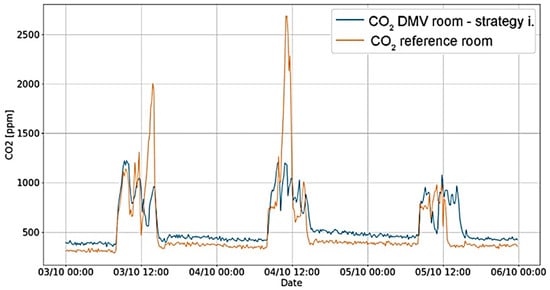
Figure 5.
CO2 concentrations were measured in the room using Strategy I (ASHRAE 62) in comparison to the reference room that was closer [35].
Rizzo et al. (2024) [36] explored strategies to optimise IAQ and thermal comfort by analysing a DCV approach integrated with CO2 sensing. The system circulates cooler outdoor air during summer nights and reuses warmer corridor air during winter to regulate classroom conditions. The study combined numerical modelling with a real-world case study. The findings indicate that while favourable outdoor conditions can make natural ventilation sufficient for maintaining IAQ in classrooms, they may also result in unnecessary energy usage due to undesirable fluctuations in indoor temperature. Despite the installation of a retrofitted ventilation system, CO2 concentrations remained below the recommended threshold for at least 76% of the year, with levels exceeding 1000 ppm for no more than 6% of the time.
Liu et al. (2025) [37] proposed an occupant-centric control (OCC) strategy that adjusts air supply vent operation and assigns sub-zone airflow based on occupancy levels. The strategy incorporates two sub-zone air distribution configurations to enhance comfort and air quality for nearby occupants. Using computational fluid dynamics (CFD), the performance of the OCC approach was evaluated within a stratum ventilation system. The results showed that at a height of 0.6 m, predicted thermal sensation votes ranged from 0.29 to 0.53, and CO2 concentrations at 1.1 m remained below 1100 ppm. Energy savings were estimated at 18–51% compared to Baseline 2 and 4–16% relative to Baseline 1. Moreover, greater discrepancies in occupancy between sub-zones resulted in increased energy savings. Airflow allocation to sub-zones was determined by their individual cooling loads, and the critical sub-zone’s outdoor air ratio was used to guide total outdoor air supply.
Referring to the aforementioned studies, several active models for ventilation rate measurement and control were proven. In this aspect, a novel CO2 estimation model attained a high accuracy of (R2 ≥ 0.998), demonstrating it to be reliable for monitoring air change rates. However, an optimised demand-controlled ventilation (DCV) system can improve the energy efficacy by 88% while preserving indoor air quality through real-time adjustments. Also, an occupant-centric ventilation control model saved 18% to 51% in energy by adjusting to residence levels. This comparative analysis signifies a balance between measurement accuracy, energy competence, and user comfort, showing a trend towards smart, adaptive ventilation solutions. Table 1 provides a summary of the studies related to ventilation rate measurement and control.

Table 1.
A summary of the studies that are related to ventilation rate measurement and control.
2.2. Studies Related to Indoor Air Quality and Health
In their study, Paul et al. (2010) [38] investigated the impact of fan-assisted ventilation on the IAQ of the Tuskegee Healthy House. To ensure consistency, the experiments were conducted under nearly identical outdoor weather conditions, comparing scenarios with the ventilation fan either turned on or off. During August 2008, daily measurements were systematically recorded, including outdoor and indoor temperature and relative humidity (RH), dust concentration, and wall moisture content. The results indicate that outdoor humidity was consistently higher than indoor humidity during the observation period, with peak humidity levels occurring late at night and early in the morning. Figure 6 introduces hourly differences in indoor and outdoor relative humidity during the “fan OFF” (August 14) and “fan ON” (August 18) periods. Specifically, indoor relative humidity remains significantly higher than outdoor levels, particularly at night when the fan is OFF. On the other hand, indoor humidity declines, falling closer to outdoor levels when the fan is ON, particularly throughout daytime. This indicates that the fan efficiently decreases indoor humidity, indorsing a more comfortable environment. Furthermore, Figure 7 depicts hourly differences in interior dust concentrations between “fan OFF” and “fan ON” periods. Through the “fan OFF” period, dust levels peak in the afternoon, while the “fan ON” period results in steadily lesser dust concentrations during the day. The data propose that utilising the fan meaningfully lessens indoor dust levels, contributing to enhanced air quality and a healthier living environment. More importantly, Figure 6 and Figure 7 indicate that the maximum outdoor relative humidity typically reachs 91% around 7–8 a.m.
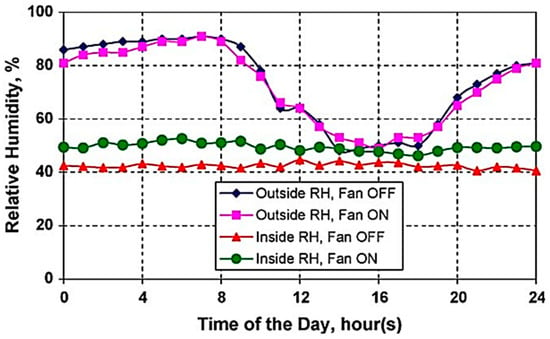
Figure 6.
Hourly differences in interior and outdoor relative humidity during the “fan OFF” (August 14) and “fan ON” (August 18) periods [38].
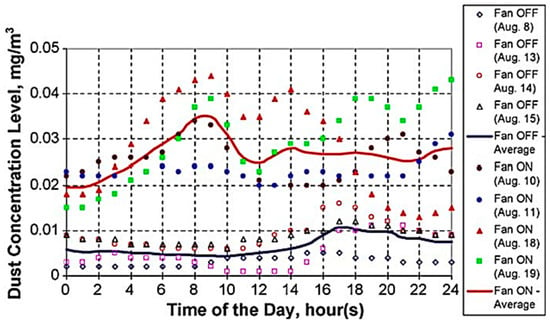
Figure 7.
Hourly differences in the concentrations of interior dust between the “fan OFF” and “fan ON” periods [38].
Yu et al. (2014) [39] conducted a study comparing the performance of constant air volume (CAV) and variable air volume (VAV) systems under conditions with elevated outdoor concentrations of CO2 and particulate matter. Key parameters, including filter efficiency, occupancy levels, hourly airflow rates, and outdoor particle concentrations, were closely monitored. A comprehensive experimental setup was implemented to analyse the behaviour of CO2 and aerosols under both steady-state and dynamic conditions. The experimental results were further validated using a previously developed state-space model. Subsequently, a detailed case study was performed based on this established mathematical model. The results indicated that both CAV and demand-controlled VAV systems equipped with CO2 sensors may lead to elevated indoor particle concentrations when outdoor particulate levels are high.
Kamendere et al. (2015) [40] investigated the effectiveness of mechanical ventilation systems with heat recovery in multi-family residential buildings following renovation. Natural ventilation strategies were also examined as part of the analysis. To collect and evaluate performance data, the authors utilized two retrofitted buildings designed to enhance both energy efficiency and indoor environmental quality. The study addresses practical challenges such as limited space and low ceiling height in existing multi-story apartment buildings, proposing the integration of supply air ducts within the wall insulation as a viable solution. As illustrated in Figure 8, CO2 concentrations increased over time. Figure 8 specifically shows that at the building on Zirnu Iela 17, CO2 levels remained above 1000 ppm approximately 68% of the time. In contrast, at Zirnu Iela 11, CO2 concentrations exceeded 1000 ppm during only 40% of the observed period. In both buildings, CO2 levels surpassed 1600 ppm for at least 8% of the time.
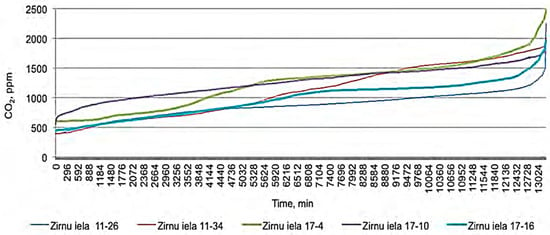
Figure 8.
CO2 level cumulative graph for two Zirnu Iela 11 apartments and three Zirnu Iela 17 apartments [40].
In their study, Lai et al. (2018) [21] examined the use of various ventilation strategies in 46 apartments across China and collected feedback from building occupants. The ventilation systems alternated automatically between natural and mechanical modes throughout the day, with natural ventilation operating for an average of 11 h and mechanical ventilation for 7.2 h daily. Ventilation usage patterns varied across regions and seasons due to climate differences. As the climate became warmer from north to south, the reliance on natural ventilation increased. Natural ventilation was used most frequently during summer and least during winter. Overall, occupants preferred natural ventilation over mechanical systems. Typically, as outdoor temperatures rose, natural ventilation use increased while mechanical ventilation decreased. The study also revealed that thermal comfort was a higher priority for residents than indoor air cleanliness. Occupants were more willing to incur energy costs for mechanical ventilation only when it clearly contributed to health-related benefits.
Zhao et al. (2018) [41] investigated the effects of both mechanical and natural ventilation on indoor temperature and humidity levels. The study was conducted in Urumqi, China, a region known for its extremely cold winters, and involved nine residential houses. Four houses utilized natural ventilation, four were equipped with heat-recovery mechanical systems, and one relied solely on mechanical ventilation. The results indicated that while Urumqi experiences dry indoor air during winter, indoor humidity becomes more comfortable during the rest of the year. Operation of mechanical ventilation systems in winter led to a 3% reduction in relative humidity and a 1.6 °C decrease in indoor temperature. As a result, residents were more likely to notice the dryness and respond by using humidifiers. Notably, indoor carbon dioxide levels remained below the regulatory limits. Figure 9 illustrates CO2 concentration levels in bedrooms during winter. More than 74% of the data showed that the indoor CO2 concentration in building N3 remained below 500 ppm, suggesting that the space was infrequently occupied. In contrast, in winter, bedrooms ventilated by MEV exceeded 1000 ppm CO2 in 4% of the recorded instances, while naturally ventilated (NV) bedrooms surpassed this threshold in 28% of measurements.
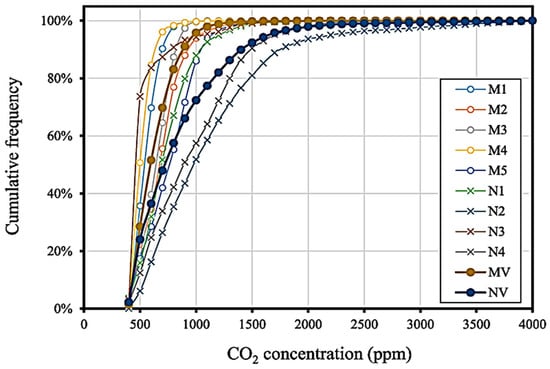
Figure 9.
For each family and two methods of dwelling ventilation, the cumulative frequency of a 1 h mean of CO2 throughout the winter [41].
In their study, Zhao and Liu (2020) [42] combined surveys with measurements of ventilation performance and indoor air quality to examine apartment ventilation behaviours and air quality outcomes. Data were collected over the course of one year from 36 apartments located in five Chinese cities representing three distinct climate zones. On average, apartments were exposed to outdoor air for approximately 9.1 h per day. Approximately 11.1% of occupants operated mechanical ventilation systems nearly continuously throughout the day, while most residents adjusted temperature settings only when necessary. During winter months, increased outdoor PM2.5 concentrations led to longer durations of fan operation. Most mechanical ventilation systems operated at approximately 50% efficiency. The average ACH was measured at 0.56, significantly below the expected standard. Interestingly, the 9 h average ventilation duration closely aligns with the typical runtime of mechanical ventilation equipment in many Chinese households. Figure 10 illustrates the relationship between indoor-to-outdoor (I/O) particulate matter ratios and the use of natural and mechanical ventilation under variable outdoor PM2.5 concentrations. Specifically, Figure 10 presents the results of different ventilation techniques including (NV, MV < 4 h, MV 4–9 h, and MV > 9 h) in terms of indoor-to-outdoor (I/O) ratios for different dust concentration categories. The box plots signify that natural ventilation (NV) consistently attains the greatest I/O ratios across all dust categories, mainly for concentrations under 35 µg/m3. On the other hand, the mechanical ventilation (MV) techniques display variable efficiencies, with MV < 4 h acting better than MV 4–9 h and MV > 9 h for lower dust levels. More importantly, as dust concentrations rise, the I/O ratios reduce for all MV techniques, signifying that longer exposure times can be less active in preserving low indoor dust levels in comparison to natural ventilation.
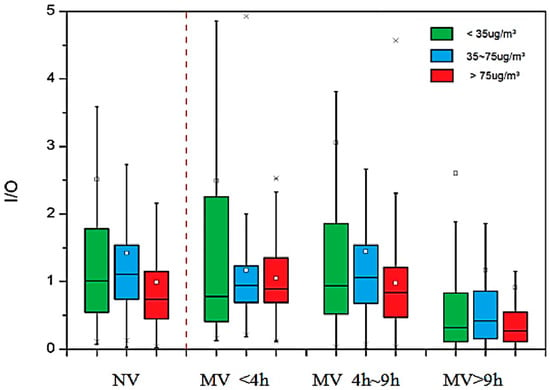
Figure 10.
The actual indoor-to-outdoor (I/O) ratios of various ventilation techniques [42].
Lim et al. (2021) [43] assessed IAQ and health symptoms in both adults and children residing in energy-efficient homes (EEHs) over the course of one year. A two-way mixed analysis of variance was conducted to examine differences in IAQ between conventional and EEH housing types. Additionally, the study employed a binomial generalized linear mixed model (GLMM) and a generalized additive mixed model to explore associations between IAQ and the daily risk of reported health symptoms. Overall, concentrations of PM10, PM2.5, CO2, and volatile organic compounds (VOCs) were significantly lower in EEHs, even after adjusting for seasonal variations. Indoor humidity and temperature levels remained relatively stable across the EEH units. The authors found that elevated indoor CO2 levels, an indicator of inadequate ventilation, were significantly associated with increased daily incidences of eye fatigue, allergic rhinitis, and atopic dermatitis. Given that EEHs substantially improved IAQ and reduced the likelihood of occupant symptoms, the study suggests that EEH design may contribute positively to general occupant health.
Antonopoulos et al. (2023) [44] conducted a field study to evaluate the operation of whole-house mechanical ventilation (WHMV) systems and their effect on IAQ in 55 homes, with detailed monitoring conducted in 16 homes over a two-week period under two conditions: with WHMV systems activated and deactivated. Among these, 30 homes were equipped with WHMV systems that met ASHRAE 62.2–2010 standard [45] and were operated either run continuously or via programmed timers. However, 35 out of 46 WHMV users reported that they did not fully understand how to operate their systems, and nearly half indicated that the controls were inadequately labelled. Satisfaction with IAQ showed minimal variation between respondents from Oregon and Colorado, although differences emerged in specific concerns: 19% of respondents in Colorado reported dissatisfaction with IAQ compared to just 3% in Oregon, while 58% of Colorado respondents reported discomfort due to dryness, compared to 14% in Oregon. The findings suggest that WHMV provides measurable IAQ benefits, though continuous operation may not be necessary in regions with low outdoor air pollution and minimal indoor sources of contamination. Figure 11 shows the mean and 10th–90th percentile range of the difference in calculated air change rates (ACR) between the two-week periods without and with whole-house mechanical ventilation (WHMV) operation in 16 monitored homes. The mean difference was 0.18 h−1 with a range of 0.08–0.33 h−1.
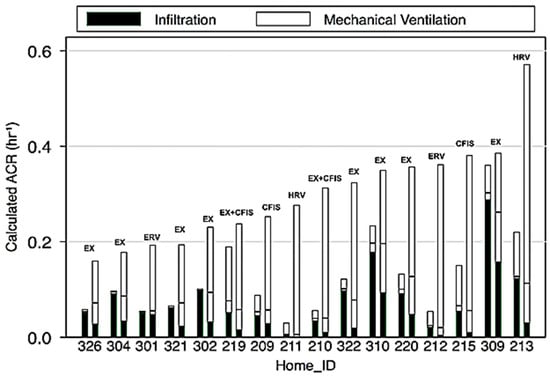
Figure 11.
Sixteen two-week residences with and without WHMV systems had their air change rates computed and arranged by ACR with WHMV [45].
Anyaegbuna et al. (2024) [46] investigated the role of mechanical ventilation in maintaining IAQ in a bank’s basement vault, a space often challenged by elevated pollutant levels. To assess the effectiveness of ventilation strategies in ensuring safe and healthy indoor conditions, the study utilized CFD using ANSYS Fluent Workbench 16.0 and CONTAM 3.2 software, both widely used for multi-zone ventilation and IAQ analysis. The study focused on three key indoor pollutants, radon—CO2, and PM2.5—highlighting the practical relevance and applicability of the findings. Simulation results showed that the predicted indoor pollutant concentrations remained below established IAQ standards. Specifically, average steady-state values in the basement were 27.2 Bq/m3 for radon, 574.80 ppm for CO2, and 69.36 µg/m3 for PM2.5. To further reduce radon levels to below 15 Bq/m3, adequate ventilation was achieved at 4.7 ACH, accompanied by a system load of 17 kW, excluding scenarios with outdoor airflow rates exceeding 10 L/s·m2. The concentration of PM2.5 on each floor was influenced by particle sources, airflow distribution, and the type of equipment in use. Figure 12 depicts the outcomes of the CONTAM PM simulation, presenting PM2.5 concentrations (µg/m3) at various ventilation rates (0, 2, 5, 7, and 10 h−1) across different floors: basement, ground floor, first floor, and second floor. Specifically, PM2.5 levels commonly reduce across all floors as ventilation rates grow, signifying the success of improved ventilation in mitigating particulate matter. The ground floor depicts the greatest PM2.5 concentrations at all rates, while the basement shows the lowest levels. Accordingly, it can be said that changes in ventilation rates had minimal impact on PM2.5 concentrations on the first floor. More generally, the study found that general mechanical ventilation had limited effectiveness in reducing particulate matter levels on other floors as well. In general, the data proposes that growing ventilation rates meaningfully improves indoor air quality by lowering PM2.5 concentrations.
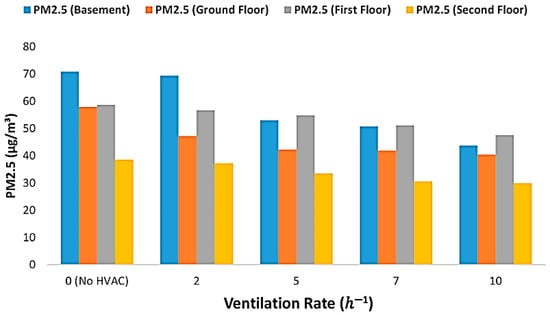
Figure 12.
Results of the CONTAM PM simulation at different ventilation rates [46].
Summa et al. (2024) [47] conducted a typological study to classify common types of classrooms utilising controlled mechanical ventilation and carried out field measurements in 58 classrooms across Italy to evaluate indoor air conditions, with a particular focus on CO2 levels. The analysis also documented heating systems and recent upgrades related to energy performance and acoustic comfort in the schools. The typological classification identified three classroom types, each with one of four mechanical ventilation configurations. The window-to-floor area ratios were approximately 25%, 30%, and 40% for wide, square, and deep classrooms, respectively. During winter, mechanical ventilation was effective in reducing CO2 concentrations. However, during mid-season and summer periods, natural ventilation became the dominant mechanism for improving IAQ, primarily due to occupant-driven window opening. Improper use of the mechanical ventilation systems, caused by noise complaints or lack of user training, was associated with CO2 levels exceeding recommended limits.
Du et al. (2025) [48] assessed indoor air quality in 24 primary schools in Switzerland, 11 of which had mechanical ventilation systems, all located in the French-speaking region. Measurements were taken over four campaigns between autumn 2021 and winter 2023, covering key periods such as the energy shortage of winter 2023. The study monitored concentrations of CO2, particulate matter (PM), and VOCs, with additional sampling for radon and nanoparticles at selected locations. During school hours, median indoor concentrations were 560 ppm for CO2 and 4 µg/m3 for PM2.5, with interquartile ranges of 450–780 ppm and 2–6 µg/m3, respectively. Total VOCs (TVOCs) averaged 41 ppb with a standard deviation of 66 ppb, reflecting measurements taken over both active and unoccupied periods (including nights and weekends). Mechanical ventilation reduced CO2 and TVOC levels by 20–30% during autumn and winter compared to natural ventilation. Notably, in winter 2022, naturally ventilated classrooms exhibited higher TVOC levels and lower CO2 concentrations than in winter 2023, likely due to increased window use and cleaning protocols.
Berneiser et al. (2025) [49] investigated the factors influencing occupant attitudes and satisfaction with mechanical ventilation. The authors examined self-reported natural ventilation practices and analysed predictors of user acceptance of mechanical systems. While many predictors overlapped, differences were noted in the degree of influence. System usability and perceived effectiveness were strong predictors of occupant satisfaction. The perceived cleanliness of the ventilation system also played a key role in shaping user perceptions. Interestingly, user preferences for greater control, low noise levels, or energy efficiency showed no statistically significant correlation with satisfaction or attitude. The findings highlight the importance of intuitive system design and ease of use in fostering positive user experiences. Furthermore, ensuring high-quality filtration and proper maintenance of ventilation systems, particularly in environments such as hotels, was identified as essential for guest satisfaction.
Ballerini et al. (2025) [50] studied the impact of a mechanical ventilation system with heat recovery (MVHR) installed in a high school classroom in Ferrara, Italy. The study monitored indoor and outdoor conditions, including temperature, RH, and CO2, with 17 students occupying the space daily throughout the academic year. These data were used to compare natural and mechanical ventilation effectiveness. Following the installation of the MVHR system, regular measurements of PM2.5, VOCs, and radon were conducted. Statistical analysis indicated improvements in both carbon dioxide levels and olfactory comfort, which contributed to enhanced general and sensory well-being and increased student attentiveness. Figure 13 presents radon levels associated with 6 h of daily mechanical ventilation, along with the 24 h average values measured during a 50-day period from 14 February to 14 April. Results show that the radon concentrations during mechanical ventilation were comparable to the daily mean, both averaging around 21 Bq/m3.
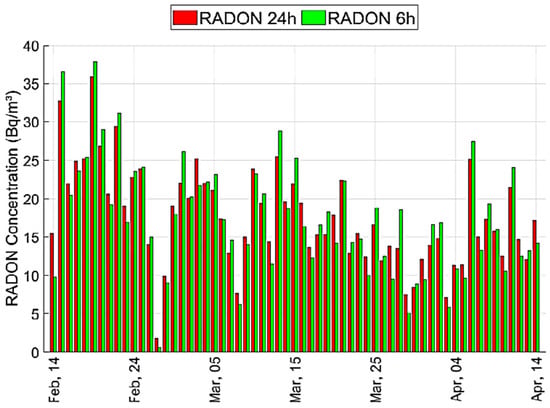
Figure 13.
The radon concentration in the classroom between 14 February and 14 April 2024 [50].
Referring to the above-discussed papers, it should be noted that the model of mechanical ventilation with heat recovery has notable performance and can enhance IAQ. However, it resulted in CO2 levels above 1000 ppm 68% of the time. On the other hand, continuous airflow ventilation (CAV) preserved stable CO2 levels but struggled with particle control in polluted conditions. Mechanical ventilation also indicated a reduction between 20 and 30% in CO2 and volatile organic compounds in comparison to natural ventilation, even though user errors frequently led to CO2 exceedances. Furthermore, the use of mechanical ventilation in bank vaults efficaciously kept radon and particulate matter below guidelines. Table 2 presents a summary of studies related to IAQ and health.

Table 2.
A summary of the studies that are related to indoor air quality and health.
2.3. Studies Related to Energy Efficiency and Heat Recovery
The study by Yassine et al. (2012) [51] investigates building design strategies aimed at reducing energy usage for thermal comfort in residential dwellings. The proposed model incorporates a proportional–integral–derivative (PID) controller and numerical simulations to predict indoor air temperature regulated through mechanical ventilation. The building design is adapted to the climate of Beirut, Lebanon, which is moderated by proximity to the sea and is generally temperate. Several ventilation and wall insulation configurations were tested in both the living and bedroom zones of an apartment. Simulation results indicate that the optimal wall configuration for the living area consists of a 5 cm layer of insulating strawboard sandwiched between two 2 cm masonry layers made of Hempcrete. For the bedroom, the most effective configuration was a single 10 cm-thick Hempcrete wall. Referring to Figure 14a, which focuses on the living area, three base scenarios and two additional cases are demonstrated while presenting the number of discomfort hours in the living area across different months. The discomfort hours peak in the summer months (especially July), showing substantial discomfort throughout warmer periods. Case 2 mostly depicts lesser discomfort hours in a comparison to the base case, proposing that specific interventions can lessen discomfort. Furthermore, Figure 14b represents the sleeping area, where the discomfort hours are particularly reduced, with negligible fluctuations during the year. Also, the base case depicts some discomfort in the warmer months, but cases 3 and 4 display a dependable decrease in discomfort hours. This indicates that the sleeping area experiences less discomfort. This is due to more active temperature control or ventilation strategies.
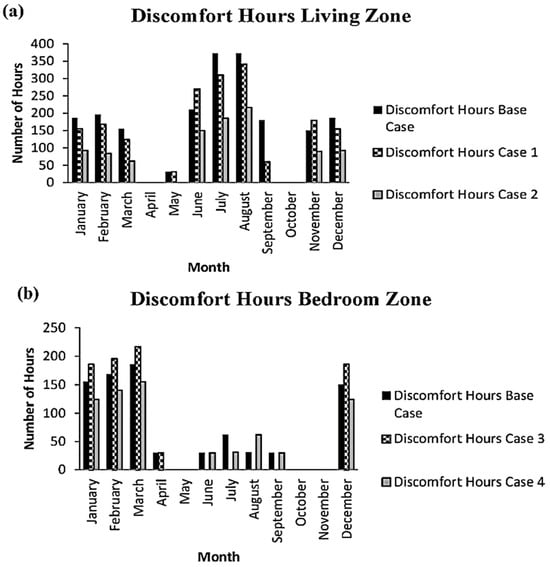
Figure 14.
Hours of pain in the various scenarios for the (a) living area and (b) sleeping area [51].
Asdrubali et al. (2015) [52] established a new experimental facility at the Thermal Engineering Laboratory of the University of Perugia to evaluate the performance of heat recovery devices used in air handling systems. Initially, the research team tested a commercial plate heat exchanger using polystyrene as the core material. Although polystyrene has low thermal conductivity, its flexibility allows for the design of thinner exchangers, enabling improved thermal efficiency despite challenges related to weight and cost. The researchers recorded flow rates, pressure drops, and all relevant temperature values associated with the heat exchanger. A series of experiments was conducted with varying temperature conditions, outdoor environments, and airflow rates to determine the unit’s energy efficiency index. As shown in Figure 15, the impact of fan speed (i.e., mass flow rate) on the performance across three test conditions is illustrated. Figure 15 specifically depicts the system’s efficacy across various mass flow rates (37.1, 53.4, and 65.6 m3/h) as demonstrated by three efficiency trends (Text 1, Text 2, and Text 3). Clearly, the system demonstrated an average efficiency exceeding 90%, with further improvement observed when the water circulation pump operated at a reduced flow rate. However, as mass flow rates rise, a minor drop in efficacy is detected across all three trends. Figure 15 also delivers further details, indicating that while efficiency remains relatively stable, the rate of drop differs among the different texts. This suggests that optimisation of mass flow rates is critical to maintain the system performance while balancing efficiency.
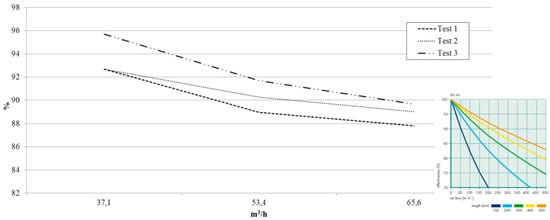
Figure 15.
The system’s efficiency at various mass flow rates and the manufacturer’s reported efficiency trend [52].
Evola et al. (2017) [53] investigated the technological, energy, and economic implications of controlled mechanical ventilation (CMV) systems in residential buildings. Based on whether an apartment unit required constant or variable airflow, several mechanical ventilation configurations were developed. Each of the proposed designs is capable of supplying fresh outdoor air while reducing indoor air pollution. These configurations were used to estimate system installation costs. The authors calculated the energy usage for each proposed setup, including the electricity required to operate the blower fan and the fuel needed to preheat cold outdoor air to indoor comfort levels. Finally, the total energy demand of these systems was compared to that of a reference building relying solely on natural ventilation through manual window operation.
Cablé et al. (2019) [54] conducted transient thermal simulations using TRNSYS Type 51 coupled with TRNFlow to evaluate two types of residential buildings: one following Norway’s passive house standard (NS3700) [55], and the other compliant with France’s building regulation (RT2012) [56]. MVHR systems were incorporated into both models. The study examined energy use and thermal comfort across seven climate zones, including Nice, France (representing a mixed climate) and Karasjok, Norway (a severe subarctic climate). The simulations revealed that in homes with MVHR, bedrooms located farthest from the central wood-burning stove experienced significantly lower temperatures, by up to 7.6 °C in France and 9.5 °C in Norway in the 95th percentile of temperature deviation, compared to homes without MVHR systems. The use of optimised wood stove controls and ventilation strategies led to heating energy savings of up to 19% over the heating season.
Sha and Qi (2020) [57] examined the application of mechanical ventilation for ventilated cooling in high-rise buildings and its potential for energy savings (Figure 16). Energy models were developed for various components of the cooling system. Several energy-saving strategies were proposed based on model analysis, including the adoption of optimal control methods, the use of energy-efficient fans, and increasing the nominal operating speed of ventilation fans. An institutional high-rise building was used as a case study to test the proposed strategies. The results showed that improvements in fan efficiency, optimised control strategies, and increased nominal ventilation flow rates can substantially reduce cooling energy usage. However, further optimisation of room ventilation rates alone was found to have a minimal impact on energy savings. Figure 17 depicts the change in the energy consumption (in MWh) against variable nominal ventilation flow rates, in addition to contrasting scenarios with and without effective fans. The baseline scenario depicts a steady energy consumption level across all tested air rates (0.94, 1.4, 2.8, 5.6, and 10 L/s·m2). Remarkably, the energy savings are minimal, with only minor decreases detected at higher ventilation rates (specified by 0.4% savings). This proposes that while raising the outdoor air rate can cause better ventilation, the effect on energy consumption is incomplete, signifying that efficient fan systems cannot considerably change energy use in these scenarios. In other words, additional energy input would be required to improve mechanical ventilation efficiency in cases where low-efficiency fans are employed.
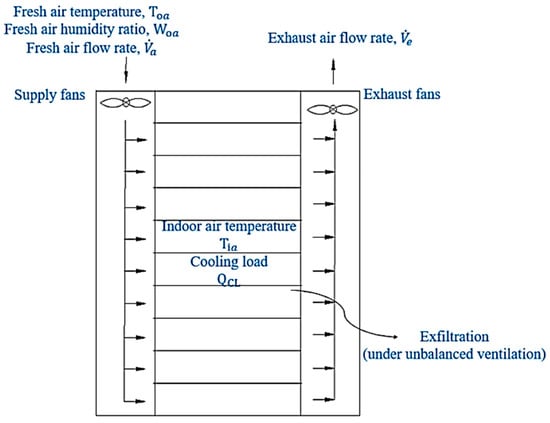
Figure 16.
Mechanical ventilation system schematic diagram [57].
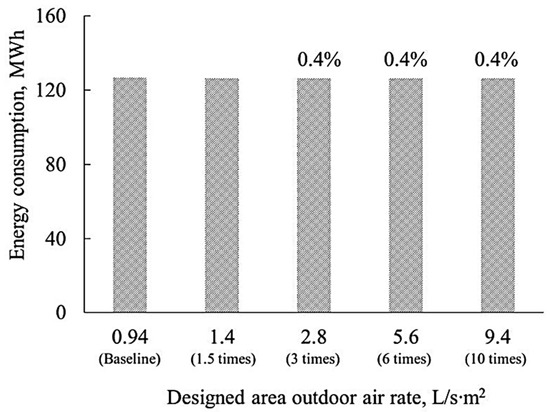
Figure 17.
Energy savings in situations with and without effective fans are impacted by the nominal ventilation flow rate [57].
Sha et al. (2021) [58] examined the performance of ventilation systems in high-rise buildings, with the dual aim of minimising cooling energy demand and reducing the risk of airborne infection. A modified Wells–Riley model was proposed to determine the dilution ventilation (DLV) rates. Additionally, the minimum ventilation rate required to achieve ventilative cooling (VC) was established. A control strategy was then developed to meet both DV and VC requirements. In the final phase of the study, a high-rise building was selected to assess the impact of design ventilation rates and mechanical ventilation settings on power consumption. Results showed that the required ventilation rates ranged from 36 m3/s to 3306 m3/s, depending on the implemented safety measures. By adopting protective strategies, mechanical ventilation energy consumption could be reduced by up to 40%.
Mechouet et al. (2021) [59] investigated the role of mechanical ventilation in improving the thermal performance of double-skin façades containing phase change materials (PCM). The study analysed the thermal and energy performance of a typical residential building in Morocco using recent typical meteorological year data. Key variables included the PCM melting temperature, PCM thickness, and the volume of circulating air. Simulation results indicated that mechanical ventilation significantly enhanced thermal comfort and reduced energy demand for air conditioning. Furthermore, economic analysis revealed that mechanical ventilation often shortened the payback period for PCM investment.
According to Korpela et al. (2022) [60], apartment buildings in the Kymenlaakso region of Finland contain recoverable waste heat that could be utilized through exhaust air heat pumps (EAHPs). In the city of Kotka, a thermal energy balance was calculated for residential buildings constructed between the 1950s and 2010, enabling identification of heat losses. Mechanical exhaust ventilation systems in these buildings were assessed, revealing that exhaust air recovery could yield 18.65 GWh/year in Kotka and 36.79 GWh/year in Kouvola if EAHPs were installed. This could lead to annual CO2 emissions reductions of 590 tonnes in Kotka and 944 tonnes in Kouvola. Based on cost recovery calculations, the payback period for EAHP installation ranged from 7 to 13 years depending on building type.
Fix et al. (2022) [61] introduced a novel membrane-based HVAC system known as the active membrane energy exchanger (AMX), designed to provide simultaneous air cooling and dehumidification. Whereas traditional membrane dehumidification systems operate under isothermal conditions, the AMX is the first to integrate membrane dehumidification with heat exchange under non-isothermal conditions. The study modelled the AMX-R configuration, which circulates both indoor and outdoor air, and identified operational limits for increasing ventilation rates. In warm and humid climates, the AMX-R system reduced electricity consumption for cooling and dehumidification by up to 50% compared to conventional systems. It also delivered nearly three times higher ventilation efficiency while using the same amount of energy. Simulations using EnergyPlus across 114 U.S. cities indicated that the AMX-R system performs optimally in southern regions.
Guan et al. (2023) [62] presented a novel collector–storage solar air heating system (CSSAHS) featuring a thermal storage unit (TSU) with a dual S-channel heat exchanger. A model of the integrated system was developed, and field testing was conducted in a selected city in China. The system included a solar air collector, heat recovery device, fan, and TSU. The study found that the temperature of incoming fresh air had the greatest influence on gas release and storage processes. Heat release efficiency increased by approximately 1.58% when the fresh air temperature ranged between –6 °C and 18 °C. Simulation analyses under various conditions were used to optimise the collector area and TSU sizing for cold-climate cities. The CSSAHS system was able to preheat fresh air for up to 5 h after storage and utilized 52% to 74% of the stored heat. A comparison of power consumption between the CSSAHS and conventional electric heating systems is presented in Figure 18. Specifically, Figure 18 contrasts the power consumption (in kWh) of the CSSAHS system against several other systems across three cities: Shenyang, Changchun, and Harbin. Each bar demonstrates the total power consumption segmented into components: the power consumption of FEH, AH, CSSAHS, the MWHR with EH system, and the total electric heating system. Specifically, the CSSAHS system depicts a discrete portion of the total power consumption in all considered cities, highlighting its efficacy in a comparison to the other systems. Clearly, power consumption is highest in Harbin, representing higher energy demands in colder climates. The data demonstrate that while CSSAHS contributes to overall power usage, it is generally more effectual than some other conventional systems, especially in extremely cold conditions. Statistically, it can be stated that the daily electricity use for electric heating is recorded as 6.05 kWh in Shenyang, 7.14 kWh in Changchun, and 7.97 kWh in Harbin.
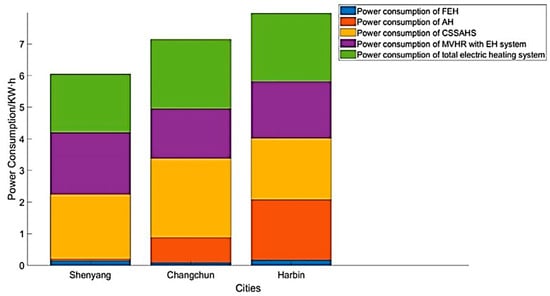
Figure 18.
Power consumption comparison between CSSAHS and other systems [62].
In their study, Miracco et al. (2025) [63] developed a novel control strategy for mechanical ventilation in classrooms, aimed at simultaneously improving IAQ and energy efficiency. The study compared two classroom types: one located above ground with external walls and windows and another partially submerged below ground level. Individual models for each classroom were created using DesignBuilder and were validated using experimental data on CO2 concentration, indoor temperature, and relative humidity. The proposed ventilation strategy is guided by real-time CO2 levels, indoor humidity, and the potential for energy savings from heating and cooling operations. Results indicate that the combined use of mechanical ventilation, heat recovery, and free cooling can reduce energy usage by up to 25% while maintaining CO2 concentrations within recommended levels to support indoor comfort and air quality. The study underscores the importance of mechanical ventilation systems in enclosed spaces, particularly in long-occupancy environments such as classrooms, for promoting both physiological and cognitive well-being.
Moghadam et al. (2025) [64] analysed a system integrating transpired solar collectors (TSC) with an MVHR unit to preheat ventilation air in a university classroom in Cork, Ireland. The study also assessed the system’s ability to maintain acceptable IAQ while achieving energy savings. Experimental monitoring of the integrated TSC-MVHR system was carried out during spring 2024. The analysis considered wind speed, airflow rate, temperature rise, and solar radiation in evaluating the TSC’s thermal performance, with results compared to findings from previous literature. The CO2 concentration, outdoor air temperature, and energy usage of the MVHR system were evaluated across various operational scenarios. The findings suggest that wind speed, mass flow rate, and air temperature rise are key variables influencing the thermal performance of the TSC. However, increased energy use by the TSC fan was found to reduce the heating efficiency of the MVHR system. Figure 19 depicts a contrast of zone air temperatures (in °C) for various HVAC designs: total bypass, solely MVHR, solely TSC (March), combined (March), solely TSC (April), and combined (April). Each box plot represents the temperature distribution, with the red shaded area signifying the comfort range of (18–22 °C). Specifically, the total bypass design depicts the highest median temperature, while the solely TSC (March) and combined (April) designs present the lowest median temperatures. The temperature ranges vary meaningfully across designs, with some demonstrating wider interquartile ranges, proposing variations in comfort levels. The data specifies that designs using total bypass and combined systems are more effective at preserving temperatures within the comfort zone in comparison to the others, chiefly during cooler months.
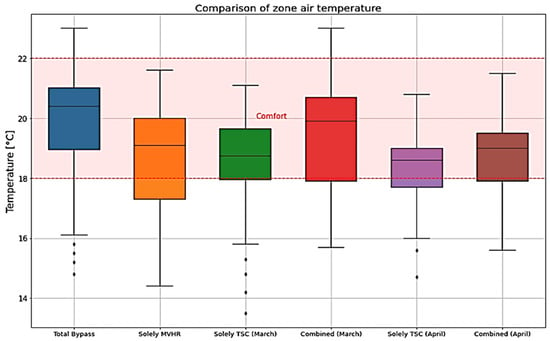
Figure 19.
Zone air temperature comparison between various designs [64].
Referring to the revised studies above, the polystyrene heat exchanger can be presented as the most efficient system, achieving a heat recovery efficacy of around 90%, predominantly at lower mass flow rates. Also, a combined wood-burning stove and mechanical ventilation system enhanced thermal comfort by up to 9.5 °C, despite saving 19% in energy. A smart continuous mechanical ventilation (CMV) control system also presented a 25% energy savings via CO2-based control while preserving indoor air quality, especially helping underground classrooms. Also, waste heat recovery from exhaust air systems indicated competitive savings of 18.7–36.8 GWh/year, meaningfully decreasing CO2 emissions. Generally, these results highlight the significance of integrating innovative energy-efficient heat recovery technologies to optimise performance while improving thermal comfort and mitigating environmental impact. Table 3 presents a summary of the studies related to energy efficiency and heat recovery.

Table 3.
A summary of the studies that are related to energy efficiency and heat recovery.
2.4. Studies Related to Thermal Comfort and Hybrid Systems
Chiang et al. (2012) [65] conducted a large-scale experiment in an office environment, complemented by a CFD simulation study of a radiant cooling ceiling system combined with air dehumidification units installed in the same space. The experimental findings were validated against the simulation results to confirm the model’s accuracy. The PMV index was used in simulations to evaluate improvements in indoor temperature and humidity under both baseline and health-enhancing scenarios. Key variables included the supply air temperature from the diffuser, the surface temperature, and the dimensions of the cooling panels. Additionally, the study examined diffuser placement within the mechanical ventilation system, leading to design recommendations for optimizing ceiling panel performance.
In a simulated room equipped with both floor-based heating/cooling and mechanical ventilation systems, Tomasi et al. (2013) [66] investigated the impact of low air change rates (1 or 0.5 ACH) on thermal comfort and ventilation effectiveness. The study considered variations in air inlet and outlet positions as well as seasonal differences between winter and summer conditions. Measurements of air temperature, operative temperature, and air velocity were collected at multiple locations and converted into equivalent temperatures for thermal comfort analysis. The contaminant removal effectiveness (CRE) and the local air change index were used to assess ventilation efficiency in the occupied zone. Thermal comfort criteria were generally satisfied; however, air temperature differences exceeding 3 °C were observed when floor cooling operated in combination with unconditioned outdoor air. Ventilation effectiveness in cooler rooms was strongly influenced by the positioning of supply and exhaust vents and the temperature gradient between them. In some cases, effectiveness dropped to as low as 0.5 when full air mixing was expected.
Wu et al. (2017) [67] examined the influence of supply air temperature on thermal comfort in rooms equipped with either floor heating (FH) or ceiling heating (CH), combined with MEV or DV. Supply air temperatures ranged from 15.0 °C to 19.0 °C. Measurements included the vertical distribution of air temperature and velocity as well as global temperature in the occupied zone. The performance of the four hybrid systems was evaluated using PMV, PPD, vertical air temperature stratification, and draught risk at neck level. PMV values ranged from 0.24 to 0.37 for FH + MV, and 0.11 to 0.27 for CH + MV; for FH + DV and CH + DV, PMV values ranged from 0.01 to 0.19 and –0.41 to –0.12, respectively. Vertical air temperature differences were less than 0.3 °C for FH + MV and CH + MV, while significantly larger gradients were observed for FH + DV (1.9 °C to 4.0 °C) and CH + DV (2.5 °C to 4.2 °C). For all configurations, both PPD values and draught rates at the neck remained below 10%.
Feng et al. (2019) [68] proposed a comprehensive particle swarm optimisation (CPSO) method for detecting contaminant sources in mechanically ventilated spaces and developed a multi-robot source localization system to validate the approach. The method was tested using three robots operating in a standard room, where the louvers of a cabinet air conditioner were repeatedly turned on and off. Validation was conducted for two standardized source locations: the downstream source (DS), located where airflow from the stack recirculates, and the return source (RS), located where air returns to the stack. Out of 15 trials, the success rates for DS and RS were 100% and 93.3%, respectively, with the robots requiring an average of 24.4 and 23.6 steps to locate the source. The CPSO method was compared with standard particle swarm optimisation (SPSO) and wind utilization II (WUII) techniques. For the DS case, only 3 out of 15 trials were successful using SPSO (20% success rate), and 6 out of 15 were successful using WUII (40% success rate), with average step counts of 33.0 and 38.0, respectively. These results demonstrate the superior performance of CPSO in source detection efficiency and accuracy.
Rimdžius et al. (2021) [69] analysed the performance of an advanced high-ventilation system designed for operation under weak wind conditions. The system enhances the function of a basic roof turbine ventilator by integrating an isobaric air tank and a turbofan within the tank. This system is powered by wind energy, a renewable and sustainable resource. Case study analysis showed that airflow could be maintained for 12–25% longer compared to conventional designs. Experimental testing of individual system components helped identify optimal configurations for maximizing system performance.
He et al. (2022) [70] evaluated the effect of roof windows and mechanical ventilation on indoor air quality in China’s first Active House. The study compared artificial and natural ventilation methods using both real-world experiments and computer simulations. Ventilation performance was assessed by measuring exhaled gas concentrations at various indoor locations and by using simulation software to visualize airflow patterns. Results indicated that combining mechanical ventilation with roof windows significantly improved indoor air circulation. The ventilation capacity using ceiling windows was found to be 1.62 times higher than that of a mechanical system alone under equivalent conditions. Proper placement of roof windows and doors was shown to facilitate effective cross-ventilation. Both experimental and simulation results emphasized that building geometry, local climate conditions, and heating system type are key factors influencing ventilation performance.
Kalmár et al. (2022) [71] conducted a study using a test room simulating a small office space to evaluate different mechanical ventilation strategies. Measurements were taken under three ventilation modes—mixing, displacement, and personalized isothermal ventilation—with one or two occupants present. CO2 emission rates were recorded at 13.4 L/h for one person and 23.63 L/h for two people. In light of increased concerns about airborne virus transmission and social distancing, the study also assessed productivity under ‘open’ and ‘screened’ desk arrangements. A pollutant balance equation was used to model CO2 concentration changes within the closed system. Visualizations of airflow patterns under each ventilation strategy were generated. Ventilation effectiveness was determined by comparing measured and modelled CO2 concentrations against the supply rate of fresh air, airflow distribution, and occupant density. Personalized ventilation, particularly when combined with a screened desk, showed the highest local pollutant removal effectiveness (1.6–2.7), compared to 0.6–1.4 for mixing and displacement ventilation (DV) modes.
Elghardouf et al. (2023) [72] developed a model to assess air pressure and velocity variations within a broiler house operating under mechanical ventilation in a Mediterranean summer climate. Experimental data, including air temperature, humidity, airspeed, and differential pressure, were collected, and simulations were performed to validate the model. The study considered natural, power, and tunnel ventilation modes. Pressure differentials at the exhaust ranged from −5 to 39 Pa, while airflow speeds varied from 0.09 to 1.641 m/s across all modes. Figure 20 contrasted simulated differential pressure (in Pascals) against experimentally measured values over a series of data points (Days 9 to 36). The brown line signifies simulated results, while the green line signifies experimental data. Clearly, the two sets of data display a close relationship, particularly in the stable ranges. However, inconsistencies are distinguished on specific days, such as Day 10 and shortly after Day 24, where the simulated values deviate from experimental measurements. These variations propose that while the simulation model generally line up well with experimental results, further refinement might be important to improve accuracy during transitional periods. Statistically, under maximum ventilation conditions, positive pressure reached 39 and 37.98 Pa in simulations and 34.37 and 34.9 Pa in observed measurements (Figure 20). Figure 21 depicts the monitored ventilation rates (in m3/s) against the rearing period, with data collected on specific days (Days 9 to 36). The green line demonstrates the ventilation rates throughout the experiment. Specifically, there are notable variations in ventilation rates, with peaks detected on several days, principally around Days 10, 24, and 25. These peaks indicate periods of growing ventilation, probably in answer to environmental conditions or animal activity. The data specify variations in ventilation needs consistent with various ages (marked as Age 1, Age 2, and Age 3), emphasising the dynamic nature of ventilation requirements across the rearing period. The findings confirm the role of strong suction pressure in drawing in fresh air through inlets and expelling warm, moist, and stale air, as illustrated in Figure 21.
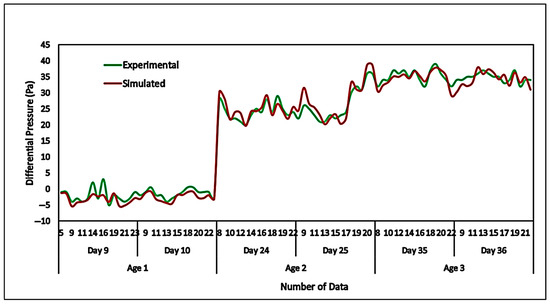
Figure 20.
Simulated differential pressure compared with experimentally measured values [72].
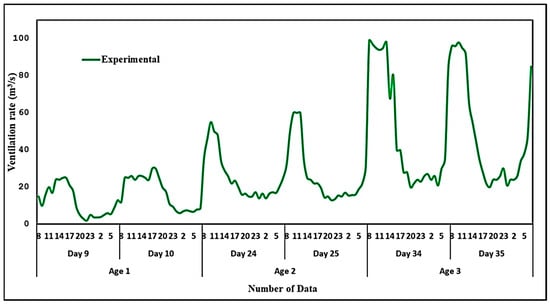
Figure 21.
Variation in monitored ventilation rates throughout the rearing period [72].
Lin et al. (2024) [73] conducted experiments in a cruise ship compartment to investigate mass loss rates, smoke temperature, and total heat transfer. The results showed that the mass loss rates of pool fires varied depending on whether ventilation was provided via natural or mechanical systems. Additionally, oceanic temperature distribution, from warmer surface layers to colder depths, was used to represent the “dual-zone model.” The longitudinal temperature profile exhibited a critical inflection point, beyond which the rate of cooling declined. A sharp temperature drop was observed between the fire source and this transition point, followed by a more gradual decrease. The study also proposed a method for determining the overall heat transfer coefficient and average gas temperature. The comprehensive heat transfer coefficient was found to be influenced by both the heat release rate and the level of mechanical ventilation. While the average gas temperature increased with greater heat release, it decreased with increasing mechanical ventilation rates.
Bai et al. (2025) [74] investigated how ventilation affects indoor air quality in high-humidity industrial buildings during winter, using both field experiments and computational modelling. The results revealed three distinct thermal and humidity regimes, depending on the ventilation rate (ACH). When ACH = 0, the space enters the “Warm-Fog Stage,” where water vapor control fails, leading to significant condensation. Under low air exchange, the cooling effect of supply air becomes dominant, often resulting in condensation damage. In fact, condensation in the occupied zone was found to be 3.3 times higher than in the no-ventilation scenario (ACH = 0). As ACH increases from 5 to 15, the condensation zone shrinks due to improved moisture removal, but the indoor temperature drops significantly, creating a “Cold-Fog Stage.” When ACH exceeds 15, cold air supply elevates the condensation zone above the occupied level. In this “Cold-Dry Stage,” the indoor air temperature closely approximates outdoor conditions, resulting in poor thermal comfort.
Riccardi et al. (2025) [75] focused on optimizing local thermal comfort while maintaining overall thermal balance. In a test room, 90 min sessions were conducted at three different ceiling water temperatures (30 °C, 35 °C, and 40 °C), while the floor temperature was maintained at a constant 18 °C. As the ceiling temperature increased, the floor surface felt relatively colder. Maintaining a balanced relationship between air and surface temperatures was essential to avoid discomfort. Participants completed questionnaires to report thermal sensations in various regions of the body. Results indicated that as the supply air became colder, discomfort was initially felt in the upper body and gradually shifted to the lower body. These findings underscore the importance of coordinated control of air and surface temperatures to ensure uniform thermal comfort.
In summary, radiant cooling combined with mechanical ventilation has been represented as the most successful model for efficiently improving thermal comfort. Specifically, hybrid radiant heating and ventilation systems preserved satisfactory comfort levels, though they generated larger temperature gradients in a comparison to mixing ventilation. Also, a roof window integrated with mechanical ventilation was found to be 1.62 times more effective than mechanical systems alone. Personalized ventilation in small offices proved to have the highest efficiency in preserving CO2 concentrations, beating other techniques. Table 4 provides a summary of studies related to thermal comfort and hybrid systems.

Table 4.
A summary of the studies that are related to thermal comfort and hybrid systems.
2.5. Studies Related to CFD and Numerical Modelling
Park and Kim (2012) [76] investigated residential ventilation behaviour and heating energy usage using field measurements, energy use data, and a resident questionnaire. The study was conducted in 139 randomly selected apartments from a residential complex in the southern region of Seoul. Among these, approximately 95 households did not use mechanical fans during heating, and 58% of them cited increased heating costs as the primary reason. Among occupants who operated mechanical fans intermittently, 31.7% used them for less than 2 h per day on average. Heating energy usage increased by approximately 32% on average (p < 0.05) when mechanical ventilation was used for 4 h daily. At the same time, occupant satisfaction with indoor air quality significantly improved (p < 0.01) with this level of usage. The average increase in total heating energy due to 4 h of fan operation was estimated at 0.07 GJ/m2.
Laverge et al. [77] evaluated the performance of residential mechanical exhaust ventilation systems based on five national standards: Belgian, British, Dutch, French, and ASHRAE. Using multi-zone simulations across common dwelling types, the authors found substantial variation in IAQ and ventilation heat loss depending on the applied standard. The Belgian, Dutch, and French standards maintained poor perceived IAQ during less than 5% of the occupancy time, while the British and ASHRAE standards exceeded 15%. However, the Dutch and ASHRAE approaches failed to achieve pareto-optimal trade-offs between IAQ and heat loss. The ASHRAE standard showed inconsistent performance across building types due to its sensitivity to geometric parameters. The British standard consistently underperformed, with air change rates around 40% below the commonly accepted 0.5 ACH benchmark. In contrast, the French standard demonstrated the most balanced and robust performance, combining moderately high exhaust rates, effective transfer devices, and minimal trickle ventilation. These findings highlighted the limitations of direct flow rate comparisons and emphasized the need for harmonized design methodologies. The study recommended using the French design philosophy as a foundation for developing uniform, high-performance residential ventilation standards.
Juraeva et al. (2013) [78] analysed airflow behaviour in a subway tunnel to improve the efficiency of its ventilation system. Using ANSYS CFX software version 2009, the steady-state airflow in the tunnel was simulated by solving the Reynolds-averaged Navier–Stokes equations. The analysis focused on the influence of mechanical ventilation shaft locations on airflow distribution. Scenarios with a guide vane, porous zone, and air curtain were simulated to assess their effects on airflow characteristics and shaft mass flow rates. It was found that the outlet air pressure from ventilation shaft 2 (located on the tunnel ceiling) was higher than that from shaft 1 (positioned along the tunnel’s side wall). Based on simulation results, the optimal connection point for shaft 2 was identified to enhance airflow distribution.
Bustamante et al. (2017) [79] employed CFD modelling to simulate airflow patterns inside broiler houses and validated their results against field measurements collected from multiple farms. The p-value for validation comparisons was 0.3908, indicating no statistically significant difference between CFD simulations and sensor-based measurements. CFD-derived air velocity values exhibited considerable variation. The minimum air velocity at bird level was 0.52 m/s with an associated uncertainty of 0.40 m/s, while the maximum recorded velocity reached 1.29 m/s with a 0.41 m/s uncertainty. The study concluded that significant airflow heterogeneity exists around the animals, and ventilation was often insufficient to support adequate convective heat loss, thereby limiting the birds’ ability to cope with high thermal loads.
Li et al. (2021) [80] conducted a detailed experimental study to investigate how mechanical ventilation operating conditions and fire behaviour affect time-varying pressure in a reduced-scale, airtight, and mechanically ventilated room. A square propane burner with a flow controller was used to simulate fire growth, featuring a doubling-growth phase, a steady-state phase (at 0.1 or 0.2 g/s), and a final quadratic decay. Eight tests were conducted under different ventilation conditions, with flow resistances ranging from 4 to 9 Pa and ventilation flow rates from 12 to 40 m3/h, corresponding to air change rates of 6.4 to 21.3 ACH. Pressure variation was found to be primarily governed by ventilation patterns, although thermal effects also played a role. Higher airflow resistance resulted in increased pressure levels. Adjusting total resistance and the individual resistance of the supply and exhaust ducts was shown to be critical in controlling pressure differentials. Fire-induced pressure and ventilation resistance jointly influenced changes in airflow rates, while gas temperatures were found to be only minimally affected by the mechanical ventilation system.
Shum and Zhong (2022) [81] developed and tested mechanical ventilation strategies for wildfire resilience in single-detached homes in Western Canada. Outdoor PM2.5 concentrations were used to characterize wildfire presence, and their impact on IAQ was evaluated using simulation models. Various mechanical ventilation retrofit options were compared in terms of cost-effectiveness and their potential to reduce health risks across different regions. Retrofit recommendations were informed by IAQ simulations, sensitivity analyses, and cost–benefit assessments. During wildfire events, the authors recommended that homes use higher-efficiency filters (MERV11 or MERV13) instead of MERV6 and increase air recirculation rates during periods of high outdoor pollution to enhance indoor protection. Under severe PM2.5 conditions, multi-stage filtration in mechanical ventilation systems was found to be necessary for maintaining safe IAQ in affected residential areas.
Torresin et al. (2024) [82] investigated behavioural and environmental factors influencing window operation and mechanical ventilation usage in 61 residential buildings across England during the summer of 2022. Their analysis explored how soundscape, landscape, noise sensitivity, and attentiveness to indoor and outdoor noise influence window-opening behaviour. Survey results from 55 dwellings showed that the primary reasons for window opening were odour removal and indoor temperature regulation, whereas the most common reasons for window closure were noise-related concerns. Additional factors included discomfort due to cold drafts, safety concerns, and insect intrusion. Most of the surveyed dwellings relied on manually operated ventilation systems, with ventilation (rather than thermal comfort or perceived indoor air quality) cited as the primary reason for activation.
In 2024, Zhu et al. [83] introduced the mechanical board-coupled ventilation shaft (MBCS) adapted from its successful application in mine ventilation systems. A total of 120 experiments were conducted in a reduced-scale tunnel model to evaluate the MBCS under varying shaft heights, board placements, and extraction velocities. The study examined the interaction between fan-driven and shaft-driven extraction modes. Results demonstrated that the MBCS significantly enhances smoke removal efficiency as extraction speed increases. Compared to conventional shafts, the new MBCS improved smoke and heat particle removal by 19.8% and 75.7%, respectively. The study also investigated the underlying dynamics of synergistic smoke extraction in road tunnels and mine ventilation systems, offering insights for future smoke control design in such infrastructures.
Regarding the revised studies related to CFD and numerical modelling, it has been demonstrated that 68.3% of apartment occupants avoided mechanical ventilation as a result to energy costs, causing an increased energy use by 32% when used intermittently to enhance IAQ. Also, multi-zone simulations highlighted that Belgian, Dutch, and French ventilation standards can provide better IAQ in a comparison to British and ASHRAE standards, with performance varying by standard. CFD was commonly used to optimise subway tunnel ventilation, where top-wall-connected shafts outpaced side-wall options. In broiler house ventilation, CFD forecasted air velocities that were inadequate for bird thermoregulation. Finally, a novel multi-branch chimney system (MBCS) established a 19.8% enhancement in smoke extraction efficacy and a 75.7% upsurge in heat extraction over conventional systems. Table 5 summarises the studies related to CFD and numerical modelling.

Table 5.
A summary of the studies that are related to CFD and numerical modelling.
3. Critical Analysis of Mechanical Ventilation in Buildings
This article provides a critical examination of the performance of mechanical ventilation systems in contemporary buildings, synthesizing findings from various studies to highlight prevailing trends and challenges. While DCV has demonstrated substantial energy-saving potential, up to 88%, and is effective in maintaining CO2 concentrations below 1000 ppm, its performance is highly dependent on accurate calibration, sensor reliability, and occupant behaviour. These are factors that are not always adequately represented in simulation models. Heat recovery systems, though theoretically efficient, often underperform in real-world applications due to maintenance deficiencies, inconsistent airflow, or environmental conditions such as high humidity. Integrating natural ventilation with mechanical systems can improve thermal comfort, as evidenced by PMV values close to 0, but this approach is vulnerable in urban areas with high levels of outdoor air pollution, which can compromise indoor air quality. Furthermore, user dissatisfaction stemming from acoustics, dryness, or lack of intuitive control highlights the necessity of human-cantered design in ventilation systems. In one study, heating energy consumption was found to increase by as much as 32% during mechanical ventilation operation, exceeding predicted values. Additionally, while advanced ventilation systems offer precision and environmental benefits, their high costs remain a significant barrier to widespread adoption.
Referring to the design of HVAC systems, it is essential to tailor solutions to specific climate zones and building types to optimise the overall performance and energy competence. In this aspect, incorporating active fan systems and utilising total bypass designs can improve indoor comfort in addition to reducing energy consumption for cold climates. Also, a balanced technique using combined HVAC designs can deliver satisfactory ventilation and temperature control without excessive energy use in moderate climates. On the other hand, selecting solely TSC systems can aid in preserving comfortable indoor environments while mitigating dependence on mechanical cooling for warmer regions. Also, monitoring ventilation rates throughout various rearing periods is important in agricultural buildings to adapt to changing thermal loads and guarantee optimum conditions for livestock. These differing approaches can deliver practical direction for designers to create well-organized, responsive, and sustainable HVAC solutions tailored to different environmental conditions. Overall, the current analysis underscores the importance of incorporating adaptive controls, efficient filtration, and occupant feedback mechanisms to ensure energy efficiency, IAQ, and thermal comfort across diverse climatic and architectural contexts. However, it should be noted that recent mechanical ventilation strategies in buildings face operational challenges and practical limitations that can deter their usefulness. Undoubtedly, the propensity for CO2 levels to surpass tolerable standards is one of the most common issues, which commonly results from user misuse, such as inappropriate adjustment of ventilation settings or failure to use systems as planned. Furthermore, inadequate maintenance—such as ignoring duct cleaning, filter changes, and system examinations—can cause decreased airflow and increased energy consumption, eventually compromising indoor air quality. These factors underline the significance of consistent maintenance and user education to assure that mechanical ventilation systems operate efficiently, preserving a healthy indoor environment while diminishing energy waste. Indeed, addressing these challenges would require interdisciplinary collaboration, post-occupancy performance monitoring, and policy incentives to accelerate the deployment of next-generation green ventilation solutions.
4. Conclusions
This comprehensive review aimed to evaluate current mechanical ventilation strategies in buildings, focusing on their influence on indoor thermal regulation, air quality, energy usage, and occupant comfort. Drawing on literature published between 2010 and 2025, the study synthesizes significant developments, persistent challenges, and emerging trends. The key findings are summarised as follows:
- DCV systems, when integrated with real-time monitoring, can reduce energy usage by up to 88% by modulating airflow based on occupancy and indoor air quality.
- Hybrid systems yielded predicted mean vote (PMV) values from –0.41 to +0.37, representing satisfactory thermal comfort under radiant heating.
- Effective operation of DCV systems depends critically on sensor accuracy, proper calibration, and regular maintenance; without these, the systems may lead to increased energy consumption and compromised air quality.
- Mechanical ventilation can reduce indoor CO2 concentrations by approximately 30% and also lower levels of pollutants such as PM2.5 and VOCs.
- Occupant behaviour significantly affects performance. When users override or disable mechanical systems, indoor CO2 concentrations may exceed recommended thresholds, undermining ventilation effectiveness.
- Heat recovery ventilation systems demonstrate efficiencies of up to 90%, reducing heating demand by approximately 19% in cold climate conditions.
- Hybrid systems that combine mechanical and natural ventilation can improve thermal comfort but are less effective in areas with high outdoor air pollution.
- User satisfaction is negatively influenced by noise, perceived dryness, and limited control over system operation. Notably, 35 out of 46 occupants surveyed reported not understanding how to operate their ventilation systems.
- Localized ventilation improves comfort in occupied zones but requires tailored airflow design to minimize drafts and prevent excessive mixing.
- CFD modelling and smart ventilation algorithms offer precise airflow management but are often cost-prohibitive, complex, and difficult to scale in existing buildings.
- Further development is needed to address challenges related to fire safety, condensation control, and the durability of components such as filters and heat exchangers.
In summary, while mechanical ventilation systems have demonstrated clear benefits in energy savings and indoor air quality, optimizing their performance across different building types and climates requires a multidisciplinary approach, robust maintenance protocols, and improved user interface design.
5. Further Enhancements and Accompanying Challenges
Improving mechanical ventilation systems requires addressing several strategic areas. Key opportunities for enhancement include the following:
- Integration of artificial intelligence (AI), Internet of Things (IoT), and machine learning is essential to optimise ventilation by adapting in real time to occupancy levels, outdoor air quality, and energy usage.
- Development of predictive algorithms that can forecast ventilation demand by incorporating weather forecasts and historical usage patterns.
- Implementation of hybrid strategies that combine natural, mechanical, and mixed-mode ventilation systems to ensure both energy efficiency and indoor air quality across different climatic conditions.
- Incorporation of backup power systems and passive ventilation strategies to ensure continuous operation during energy outages, particularly for critical infrastructure such as data centres.
- Innovation in heat exchanger materials and designs that increase performance while minimising maintenance requirements.
- Exploration of PCMs and thermoelectric systems to enhance thermal regulation capabilities.
- Development of personalized ventilation controls that allow occupants to adjust airflow without compromising the system’s overall energy performance.
- Design of user-friendly interfaces that provide real-time feedback on system status and performance, supporting timely maintenance and informed user interaction.
- Integration of renewable energy sources, such as solar, wind, or geothermal systems, to reduce reliance on grid electricity for ventilation.
- Use of energy storage systems, such as batteries or thermal storage, to manage peak energy loads and ensure stable operation.
- Formulation of unified ventilation standards applicable across various building types and climate zones.
- Proposal of policy incentives to encourage the retrofit of older buildings with energy-efficient ventilation technologies.
Despite these promising directions, several challenges continue to hinder the widespread adoption and effective operation of advanced mechanical ventilation systems:
- High initial costs associated with smart control technologies, heat recovery systems, and renewable integration deter adoption, especially in developing regions.
- Ongoing maintenance expenses, such as filter replacements and routine servicing, contribute to long-term operating costs.
- Performance limitations in hot, humid, or heavily polluted environments reduce the efficiency of some systems.
- Lack of localized guidelines results in suboptimal strategies for tropical, arid, or polar climate zones.
- Occupant resistance to automated controls, due to perceived noise, reduced autonomy, or discomfort, can limit system use.
- Low user engagement may lead to improper operation, system overrides, or neglect, negating potential benefits.
- Sensor inaccuracies, particularly for CO2 and humidity, can result in incorrect ventilation rates, wasting energy or compromising air quality.
- The complexity of CFD and AI-based models often restricts their implementation to specialists, limiting scalability.
- Condensation, moisture, and mould issues may arise in warm climates if airflow is insufficient.
- Fire safety concerns increase in buildings with extensive mechanical infrastructure, particularly during emergencies.
- Inconsistent building codes and inspection standards across regions create regulatory and compliance barriers.
- Limited public understanding of ventilation’s health and energy benefits can reduce interest in adopting modern systems.
Addressing these challenges requires interdisciplinary collaboration, regulatory support, and the development of accessible, adaptable, and user-centric ventilation solutions tailored to diverse environments and building types.
Author Contributions
Conceptualization, F.L.R. and M.A.A.-O.; methodology, F.L.R., M.A.A.-O. and N.M.L.A.M.; formal analysis, F.L.R., M.A.A.-O., N.M.L.A.M., A.A., E.B.A., A.C. and M.K.; investigation, F.L.R. and M.A.A.-O.; resources, N.M.L.A.M., A.A., E.B.A., A.C. and M.K.; writing—original draft preparation, F.L.R. and M.A.A.-O.; writing—review and editing, F.L.R., M.A.A.-O., N.M.L.A.M., A.A., E.B.A., A.C. and M.K.; visualization, A.A., E.B.A., A.C. and M.K.; supervision, F.L.R. and M.A.A.-O.; project administration, F.L.R., M.A.A.-O. and A.A. All authors have read and agreed to the published version of the manuscript.
Funding
This research received no external funding.
Data Availability Statement
Data sharing is not applicable.
Conflicts of Interest
The authors declare no conflicts of interest.
Abbreviations
The following abbreviations are used in this manuscript:
| ACH | Air Changes per Hour (h−1) |
| AMX | Active Membrane Energy Exchanger |
| CAV | Constant Air Volume |
| CFD | Computational Fluid Dynamics |
| CH | Ceiling Heating |
| CMV | Controlled Mechanical Ventilation |
| CO2 | Carbon Dioxide |
| CRE | Contaminant Removal Effectiveness |
| DALY | Disability-Adjusted Life Year |
| DCV | Demand-Controlled Ventilation |
| DLV | Dilution Ventilation |
| DMV | Demand-Controlled Mechanical Ventilation |
| DR | Draught Rate |
| DV | Displacement Ventilation |
| EAHP | Exhaust Air Heat Pumps |
| EEH | Energy-Efficient Home |
| ESP | Energy-Saving Performance |
| FH | Floor Heating |
| GLMM | Generalized Linear Mixed Model |
| HRV | Heat Recovery Ventilation |
| IAQ | Indoor Air Quality |
| MBCS | Mechanical Board-Coupled Shaft |
| MEV | Mechanical Ventilation |
| MLE | Maximum Likelihood Estimation |
| MVHR | Mechanical Ventilation with Heat Recovery |
| NPV | Net Present Value |
| NV | Natural Ventilation |
| OCC | Occupant-Centric Control |
| PCM | Phase-Change Material |
| PMV | Predicted Mean Vote |
| PPD | Predicted Percentage Dissatisfied |
| PM2.5 | Particulate Matter ≤2.5 µm |
| R2 | Coefficient of determination |
| RH | Relative Humidity |
| TDV | Time-Dependent Valuation |
| TSC | Transpired Solar Collector |
| VAV | Variable Air Volume |
| VC | Ventilative Cooling |
| VOC | Volatile Organic Compound |
| WHMV | Whole-House Mechanical Ventilation |
References
- Prüss-Üstün, A.; Wolf, J.; Corvalán, C.F.; Bos, R.; Neira, M.P. Preventing Disease Through Healthy Environments: A Global Assessment of the Burden of Disease from Environmental Risks; World Health Organization: Geneva, Switzerland, 2016; Available online: https://iris.who.int/handle/10665/204585 (accessed on 22 January 2025).
- World Health Organization, Regional Office for Europe. WHO Guidelines for Indoor Air Quality: Dampness and Mould; WHO Europe: Copenhagen, Denmark, 2009. [Google Scholar]
- Ding, E.; Zhang, D.; Bluyssen, P.M. Ventilation regimes of school classrooms against airborne transmission of infectious respiratory droplets: A review. Build. Environ. 2022, 207, 108484. [Google Scholar] [CrossRef]
- Abuhegazy, M.; Talaat, K.; Anderoglu, O.; Poroseva, S.V. Numerical investigation of aerosol transport in a classroom with relevance to COVID-19. Phys. Fluids 2020, 32, 103311. [Google Scholar] [CrossRef]
- Li, H.; Zhong, K.; Zhai, Z. Investigating the influences of ventilation on the fate of particles generated by patient and medical staff in operating room. Build. Environ. 2020, 180, 107038. [Google Scholar] [CrossRef]
- United Nations Environment Programme, Global Alliance for Buildings and Construction. 2020 Global Status Report for Buildings and Construction: Towards a Zero-Emissions, Efficient and Resilient Buildings and Construction Sector—Executive Summary; United Nations Environment Programme, Global Alliance for Buildings and Construction: Paris, France, 2020; Available online: https://wedocs.unep.org/20.500.11822/34572 (accessed on 24 January 2025).
- Energiewende, A. Die Energiewende in Deutschland: Stand der Dinge 2021: Rückblick auf die Wesentlichen Entwicklungen Sowie Ausblick auf 2022; Agora Energiewende: Berlin, Germany, 2022. [Google Scholar]
- Aydin, E.; Kok, N.; Brounen, D. Energy efficiency and household behavior: The rebound effect in the residential sector. Rand J. Econ. 2017, 48, 749–782. [Google Scholar] [CrossRef]
- Mysen, M.; Berntsen, S.; Nafstad, P.; Schild, P.G. Occupancy density and benefits of demand-controlled ventilation in Norwegian primary schools. Energy Build. 2005, 37, 1234–1240. [Google Scholar] [CrossRef]
- Olgyay, V.; Olgyay, A.; Lyndon, D.; Olgyay, V.W.; Reynolds, J.; Yeang, K. Design with Climate: Bioclimatic Approach to Architectural Regionalism; New and Expanded Edition; Princeton University Press: Princeton, NJ, USA, 2015. [Google Scholar]
- Heiselberg, P. IEA EBC Annex 62—Ventilative Cooling Design Guide; Aalborg University: Aalborg, Denmark, 2018. [Google Scholar]
- Chiesa, G. (Ed.) Bioclimatic Approaches in Urban and Building Design; Springer International Publishing: Cham, Switzerland, 2021. [Google Scholar] [CrossRef]
- Rashid, F.L.; Al-Obaidi, M.A.; Hatem, W.A.; Al Maimuri, N.M.; Ameen, A.; Ahmad, S.; Agyekum, E.B.; Kadhim, S.A.; Hammoodi, K.A. Optimising phase change materials for ventilated building components in sustainable building design: A comprehensive review. Energy Build. 2025, 343, 115947. [Google Scholar] [CrossRef]
- Persily, A. Challenges in developing ventilation and indoor air quality standards: The story of ASHRAE Standard 62. Build. Environ. 2015, 91, 61–69. [Google Scholar] [CrossRef]
- Griffiths, M.; Eftekhari, M. Control of CO2 in a naturally ventilated classroom. Energy Build 2008, 40, 556–560. [Google Scholar] [CrossRef]
- Costanzo, S.; Cusumano, A.; Giaconia, C. Ventilation rates and unsatisfied percentage from indoor CO2 concentration. Indoor Built Environ. 2011, 20, 232–245. [Google Scholar] [CrossRef]
- World Health Organization. WHO Global Air Quality Guidelines: Particulate Matter (PM2.5 and PM10), Ozone, Nitrogen Dioxide, Sulfur Dioxide and Carbon Monoxide. 2021. Available online: https://www.who.int/publications/i/item/9789240034228 (accessed on 28 January 2025).
- Gaihre, S.; Semple, S.; Miller, J.; Fielding, S.; Turner, S. Classroom carbon dioxide concentration, school attendance, and educational attainment. J. Sch. Health 2014, 84, 569–574. [Google Scholar] [CrossRef]
- Baborska-Narozny, M.; Stevenson, F. Mechanical ventilation in housing: Understanding in-use issues. Proc. Inst. Civ. Eng.-Eng. Sustain. 2017, 170, 33–46. [Google Scholar] [CrossRef]
- Cali, D.; Andersen, R.K.; Osterhage, T.; Wessling, M.; Müller, D.; Olesen, B.W. Analysis of the occupant’s behavior related to natural ventilation. In Proceedings of the 12th REHVA World Congress, Aalborg, Denmark, 22–25 May 2016. [Google Scholar]
- Lai, D.; Qi, Y.; Liu, J.; Dai, X.; Zhao, L.; Wei, S. Ventilation behavior in residential buildings with mechanical ventilation systems across different climate zones in China. Build. Environ. 2018, 143, 679–690. [Google Scholar] [CrossRef]
- Maier, D. Aufbau und Durchführung einer Mixed-Methods-Studie zu Lüftungsverhalten und Raumklima sowie der Einstellung bezüglich Lüftungssystemen: Development and Application of a Mixed-Methods-Survey About Ventilation Behavior and Room Climate as Well as Attitude Towards Ventilation Systems. Master’s Thesis, Catholic University of Eichstätt-Ingolstadt, Freiburg, Germany, 2020. [Google Scholar]
- Kanama, N.; Ondarts, M.; Guyot, G.; Outin, J.; Golly, B.; Gonze, E. Effect of energy renovation on indoor air quality and thermal environment in winter of a primary school in a highly polluted French alpine valley. J. Build. Eng. 2023, 72, 106529. [Google Scholar] [CrossRef]
- Du, B.; Reda, I.; Licina, D.; Kapsis, C.; Qi, D.; Candanedo, J.A.; Li, T. Estimating air change rate in mechanically ventilated classrooms using a single CO2 sensor and automated data segmentation. Environ. Sci. Technol. 2024, 58, 18788–18799. [Google Scholar] [CrossRef] [PubMed]
- Nowak-Dzieszko, K.; Mijakowski, M.; Müller, J. Simulating the natural seasonal ventilation of a classroom in Poland based on measurements of the CO2 concentration. Energies 2024, 17, 4591. [Google Scholar] [CrossRef]
- Calvet, S.; Cambra-López, M.; Blanes-Vidal, V.; Estellés, F.; Torres, A.G. Ventilation rates in mechanically-ventilated commercial poultry buildings in Southern Europe: Measurement system development and uncertainty analysis. Biosyst. Eng. 2010, 106, 423–432. [Google Scholar] [CrossRef]
- Lu, T.; Knuutila, A.; Viljanen, M.; Lu, X. A novel methodology for estimating space air change rates and occupant CO2 generation rates from measurements in mechanically-ventilated buildings. Build. Environ. 2010, 45, 1161–1172. [Google Scholar] [CrossRef]
- Turner, W.J.N.; Logue, J.M.; Wray, C.P. A combined energy and IAQ assessment of the potential value of commissioning residential mechanical ventilation systems. Build. Environ. 2013, 60, 194–201. [Google Scholar] [CrossRef]
- CEC. Title 24, Part 6, California Code of Regulations: California’s Energy Efficiency Standards for Residential and Nonresidential Buildings. Part 6. California Energy Commission. 2008. Available online: https://www.diamondbarca.gov/DocumentCenter/View/91/2008-Energy-Efficiency-Standards-Guide-PDF (accessed on 25 March 2025).
- ANSI/ASHRAE Standard 62.2-2016; Ventilation and Acceptable Indoor Air Quality in Low-Rise Residential Buildings. American Society of Heating, Ventilating, and Air Conditioning Engineers: Atlanta, GA, USA, 2016.
- Shi, Y.; Li, X. A study on variation laws of infiltration rate with mechanical ventilation rate in a room. Build. Environ. 2018, 143, 269–279. [Google Scholar] [CrossRef]
- Shi, Y.; Li, X. Effect of mechanical ventilation on infiltration rate under stack effect in buildings with multilayer windows. Build. Environ. 2020, 170, 106594. [Google Scholar] [CrossRef]
- Zhang, S.; Ai, Z.; Lin, Z. Novel demand-controlled optimization of constant-air-volume mechanical ventilation for indoor air quality, durability and energy saving. Appl. Energy 2021, 293, 116954. [Google Scholar] [CrossRef]
- Shin, H.; Kwak, Y.; Jo, S.-K.; Kim, S.-H.; Huh, J.-H. Development of an optimal mechanical ventilation system control strategy based on weather forecasting data for outdoor air cooling in livestock housing. Energy 2023, 268, 126649. [Google Scholar] [CrossRef]
- Chiesa, G.; Vigliotti, M. Comparing mechanical ventilation control strategies for indoor air quality: Monitoring and simulation results of a school building in northern Italy. Energy Build. 2024, 322, 114665. [Google Scholar] [CrossRef]
- Rizzo, K.; Camilleri, M.; Gatt, D.; Yousif, C. Optimising Mechanical Ventilation for Indoor Air Quality and Thermal Comfort in a Mediterranean School Building. Sustainability 2024, 16, 766. [Google Scholar] [CrossRef]
- Liu, Y.; Dang, R.; Yang, B.; Liu, P. Energy-efficient control strategy for air conditioning and mechanical ventilation system based on occupant distribution -A case study on stratum ventilation. J. Build. Eng. 2025, 100, 111709. [Google Scholar] [CrossRef]
- Paul, T.; Sree, D.; Aglan, H. Effect of mechanically induced ventilation on the indoor air quality of building envelopes. Energy Build. 2010, 42, 326–332. [Google Scholar] [CrossRef]
- Yu, C.K.H.; Li, M.; Chan, V.; Lai, A.C.K. Influence of mechanical ventilation system on indoor carbon dioxide and particulate matter concentration. Build. Environ. 2014, 76, 73–80. [Google Scholar] [CrossRef] [PubMed]
- Kamendere, E.; Zogla, G.; Kamenders, A.; Ikaunieks, J.; Rochas, C. Analysis of Mechanical Ventilation System with Heat Recovery in Renovated Apartment Buildings. Energy Procedia 2015, 72, 27–33. [Google Scholar] [CrossRef]
- Zhao, Y.; Sun, H.; Tu, D. Effect of mechanical ventilation and natural ventilation on indoor climates in Urumqi residential buildings. Build. Environ. 2018, 144, 108–118. [Google Scholar] [CrossRef]
- Zhao, L.; Liu, J. Operating behavior and corresponding performance of mechanical ventilation systems in Chinese residential buildings. Build. Environ. 2020, 170, 106600. [Google Scholar] [CrossRef]
- Lim, A.-Y.; Yoon, M.; Kim, E.-H.; Kim, H.-A.; Lee, M.J.; Cheong, H.-K. Effects of mechanical ventilation on indoor air quality and occupant health status in energy-efficient homes: A longitudinal field study. Sci. Total Environ. 2021, 785, 147324. [Google Scholar] [CrossRef] [PubMed]
- Antonopoulos, C.A.; Rosenberg, S.I.; Zhao, H.; Walker, I.S.; Delp, W.W.; Chan, W.R.; Singer, B.C. Mechanical ventilation and indoor air quality in recently constructed U.S. homes in marine and cold-dry climates. Build. Environ. 2023, 245, 110480. [Google Scholar] [CrossRef]
- ANSI/ASHRAE Standard 62.2-2010; Ventilation and Acceptable Indoor Air Quality in Low-Rise Residential Buildings. American Society of Heating, Ventilating, and Air Conditioning Engineers: Atlanta, GA, USA, 2010.
- Anyaegbuna, B.E.; Onokwai, A.O.; Anyaegbuna, N.T.; Iweriolor, S.; Anyaegbuna, I.D.; Adegun, I.K.; Fayomi, O.S.; Ighravwe, D.E.; Onifade, M.K. Numerical analysis on mechanical ventilation impact on indoor air quality in a basement. Sci. Afr. 2024, 25, e02310. [Google Scholar] [CrossRef]
- Summa, S.; Remia, G.; Di Perna, C.; Stazi, F. Mechanically ventilated classrooms in central Italy’s heritage school buildings: Proposal of archetypes and CO2 prediction models. Build. Environ. 2024, 265, 111963. [Google Scholar] [CrossRef]
- Du, B.; Rey, J.F.; Cesari, M.; Roulet, C.-A.; Favreau, P.; Perret, V.; Suarez, G.; Jörin, C.H.; Pernot, J.G.; Licina, D. Indoor air quality in swiss primary schools: Impacts of mechanical ventilation and seasonal variation. Build. Environ. 2025, 280, 113146. [Google Scholar] [CrossRef]
- Berneiser, J.; Maier, D.; Gölz, S.; Auerswald, S.; Dinkel, A. Socio-technical perspectives for mechanical ventilation systems in buildings: Predictors of attitude and user satisfaction. Energy Effic. 2025, 18, 14. [Google Scholar] [CrossRef]
- Ballerini, V.; Coccagna, M.; Bisi, M.; Volta, A.; Droghetti, L.; di Schio, E.R.; Valdiserri, P.; Mazzacane, S. The Role of Mechanical Ventilation in Indoor Air Quality in Schools: An Experimental Comprehensive Analysis. Buildings 2025, 15, 869. [Google Scholar] [CrossRef]
- Yassine, B.; Ghali, K.; Ghaddar, N.; Srour, I.; Chehab, G. A numerical modeling approach to evaluate energy-efficient mechanical ventilation strategies. Energy Build. 2012, 55, 618–630. [Google Scholar] [CrossRef]
- Asdrubali, F.; Baldinelli, G.; Bianchi, F.; Cornicchia, M. Experimental Performance Analyses of a Heat Recovery System for Mechanical Ventilation in Buildings. Energy Procedia 2015, 82, 465–471. [Google Scholar] [CrossRef]
- Evola, G.; Gagliano, A.; Marletta, L.; Nocera, F. Controlled mechanical ventilation systems in residential buildings: Primary energy balances and financial issues. J. Build. Eng. 2017, 11, 96–107. [Google Scholar] [CrossRef]
- Cablé, A.; Georges, L.; Peigné, P.; Skreiberg, Ø.; Druette, L. Evaluation of a new system combining wood-burning stove, flue gas heat exchanger and mechanical ventilation with heat recovery in highly-insulated houses. Appl. Therm. Eng. 2019, 157, 113693. [Google Scholar] [CrossRef]
- NS 3700:2013 Criteria for Passive Houses and Low Energy Buildings—Residential Buildings. Available online: https://standard.no/fagomrader/energi-og-klima-i-bygg/passivhus/ (accessed on 2 April 2025).
- RT 2012. Available online: https://climate-laws.org/document/thermal-regulation-2012-rt-2012_9132 (accessed on 12 April 2025).
- Sha, H.; Qi, D. Investigation of mechanical ventilation for cooling in high-rise buildings. Energy Build. 2020, 228, 110440. [Google Scholar] [CrossRef]
- Sha, H.; Zhang, X.; Qi, D. Optimal control of high-rise building mechanical ventilation system for achieving low risk of COVID-19 transmission and ventilative cooling. Sustain. Cities Soc. 2021, 74, 103256. [Google Scholar] [CrossRef]
- Mechouet, A.; Oualim, E.M.; Mouhib, T. Effect of mechanical ventilation on the improvement of the thermal performance of PCM-incorporated double external walls: A numerical investigation under different climatic conditions in Morocco. J. Energy Storage 2021, 38, 102495. [Google Scholar] [CrossRef]
- Korpela, T.; Kuosa, M.; Sarvelainen, H.; Tuliniemi, E.; Kiviranta, P.; Tallinen, K.; Koponen, H.-K. Waste heat recovery potential in residential apartment buildings in Finland’s Kymenlaakso region by using mechanical exhaust air ventilation and heat pumps. Int. J. Thermofluids 2022, 13, 100127. [Google Scholar] [CrossRef]
- Fix, A.J.; Pamintuan, B.C.; Braun, J.E.; Warsinger, D.M. Vapor-Selective Active Membrane Energy Exchanger with Mechanical Ventilation and Indoor Air Recirculation. Appl. Energy 2022, 312, 118768. [Google Scholar] [CrossRef]
- Guan, J.; Huang, K.; Xu, J.; Feng, G.; Song, J. Performance of a collector-storage solar air heating system for building mechanical ventilation preheating in the cold area. Energy Built Environ. 2023, 4, 639–652. [Google Scholar] [CrossRef]
- Miracco, G.; Nicoletti, F.; Ferraro, V.; Kaliakatsos, D. Innovative Mechanical Ventilation Control for Enhanced Indoor Air Quality and Energy Efficiency. Energy Eng. 2025, 122, 861–883. [Google Scholar] [CrossRef]
- Moghadam, T.T.; Bruton, K.; O’Sullivan, D.T.J.; Norton, B. Energy efficient achievement of indoor air quality and thermal comfort using mechanical ventilation heat recovery and solar-energy pre-heating. Energy Convers. Manag. 2025, 327, 119528. [Google Scholar] [CrossRef]
- Chiang, W.-H.; Wang, C.-Y.; Huang, J.-S. Evaluation of cooling ceiling and mechanical ventilation systems on thermal comfort using CFD study in an office for subtropical region. Build. Environ. 2012, 48, 113–127. [Google Scholar] [CrossRef]
- Tomasi, R.; Krajčík, M.; Simone, A.; Olesen, B.W. Experimental evaluation of air distribution in mechanically ventilated residential rooms: Thermal comfort and ventilation effectiveness. Energy Build. 2013, 60, 28–37. [Google Scholar] [CrossRef]
- Wu, X.; Liu, Y.; Liu, G.; Wang, F.; Wang, Z. Effect of Supply Air Temperature on Indoor Thermal Comfort in a Room with Radiant Heating and Mechanical Ventilation. Energy Procedia 2017, 121, 206–213. [Google Scholar] [CrossRef]
- Feng, Q.; Cai, H.; Chen, Z.; Yang, Y.; Lu, J.; Li, F.; Xu, J.; Li, X. Experimental study on a comprehensive particle swarm optimization method for locating contaminant sources in dynamic indoor environments with mechanical ventilation. Energy Build. 2019, 196, 145–156. [Google Scholar] [CrossRef] [PubMed]
- Rimdžius, D.; Bielskus, J.; Streckienė, G.; Motuzienė, V.; Martinaitis, V. Operation analysis of the developed building ventilation system using turbofans and mechanical wind energy storage. Build. Environ. 2021, 196, 107703. [Google Scholar] [CrossRef]
- He, Y.; Chu, Y.; Zang, H.; Zhao, J.; Song, Y. Experimental and CFD study of ventilation performance enhanced by roof window and mechanical ventilation system with different design strategies. Build. Environ. 2022, 224, 109566. [Google Scholar] [CrossRef]
- Kalmár, T.; Szodrai, F.; Kalmár, F. Experimental study of local effectiveness in the case of balanced mechanical ventilation in small offices. Energy 2022, 244, 122619. [Google Scholar] [CrossRef]
- Elghardouf, N.; Lahlouh, I.; Elakkary, A.; Sefiani, N. Towards modelling, and analysis of differential pressure and air velocity in a mechanical ventilation poultry house: Application for hot climates. Heliyon 2023, 9, e12936. [Google Scholar] [CrossRef]
- Lin, J.; Li, S.; Lu, S.; Chen, G.; Xue, Z. Large-scale experimental study on the average temperature distribution model of fire smoke under mechanical ventilation in the flat space. Int. J. Therm. Sci. 2024, 204, 109228. [Google Scholar] [CrossRef]
- Bai, Y.; Zhang, C.; Wang, Y.; Cao, Z.; Yang, Z.; Zhai, C.; Lv, W.; Zhao, T. Effect of mechanical ventilation on indoor environment and condensation in high-humidity industrial buildings during winter: Field investigation and numerical study. Build. Environ. 2025, 280, 113133. [Google Scholar] [CrossRef]
- Riccardi, B.; Marigo, M.; Tognon, G.; De Carli, M.; Zarrella, A. Investigation of the localized discomfort due to vertical radiant asymmetry in a test room with radiant and mechanical ventilation systems. Appl. Therm. Eng. 2025, 274, 126787. [Google Scholar] [CrossRef]
- Park, J.S.; Kim, H.J. A field study of occupant behavior and energy consumption in apartments with mechanical ventilation. Energy Build. 2012, 50, 19–25. [Google Scholar] [CrossRef]
- Laverge, J.; Pattyn, X.; Janssens, A. Performance assessment of residential mechanical exhaust ventilation systems dimensioned in accordance with Belgian, British, Dutch, French and ASHRAE standards. Build. Environ. 2013, 59, 177–186. [Google Scholar] [CrossRef]
- Juraeva, M.; Ryu, K.J.; Jeong, S.-H.; Song, D.J. Influence of mechanical ventilation-shaft connecting location on subway tunnel ventilation performance. J. Wind Eng. Ind. Aerodyn. 2013, 119, 114–120. [Google Scholar] [CrossRef]
- Bustamante, E.; Calvet, S.; Estellés, F.; Torres, A.G.; Hospitaler, A. Measurement and numerical simulation of single-sided mechanical ventilation in broiler houses. Biosyst. Eng. 2017, 160, 55–68. [Google Scholar] [CrossRef]
- Li, J.; Prétrel, H.; Suard, S.; Beji, T.; Merci, B. Experimental study on the effect of mechanical ventilation conditions and fire dynamics on the pressure evolution in an air-tight compartment. Fire Saf. J. 2021, 125, 103426. [Google Scholar] [CrossRef]
- Shum, C.; Zhong, L. Wildfire-resilient mechanical ventilation systems for single-detached homes in cities of Western Canada. Sustain. Cities Soc. 2022, 79, 103668. [Google Scholar] [CrossRef]
- Torresin, S.; Aletta, F.; Oberman, T.; Albatici, R.; Kang, J. Factors influencing window opening behavior and mechanical ventilation usage during summertime: A case study in UK dwellings. Build. Environ. 2024, 263, 111880. [Google Scholar] [CrossRef]
- Zhe, B.; Cong, H.; Yu, B.; Shao, Z.; Ye, L.; Bi, Y.; Zeng, Y. Experimental study on the performance of synergistic ventilation system combining shaft with mechanical ventilation in extra-long road tunnels. Tunn. Undergr. Space Technol. 2024, 147, 105706. [Google Scholar] [CrossRef]
Disclaimer/Publisher’s Note: The statements, opinions and data contained in all publications are solely those of the individual author(s) and contributor(s) and not of MDPI and/or the editor(s). MDPI and/or the editor(s) disclaim responsibility for any injury to people or property resulting from any ideas, methods, instructions or products referred to in the content. |
© 2025 by the authors. Licensee MDPI, Basel, Switzerland. This article is an open access article distributed under the terms and conditions of the Creative Commons Attribution (CC BY) license (https://creativecommons.org/licenses/by/4.0/).